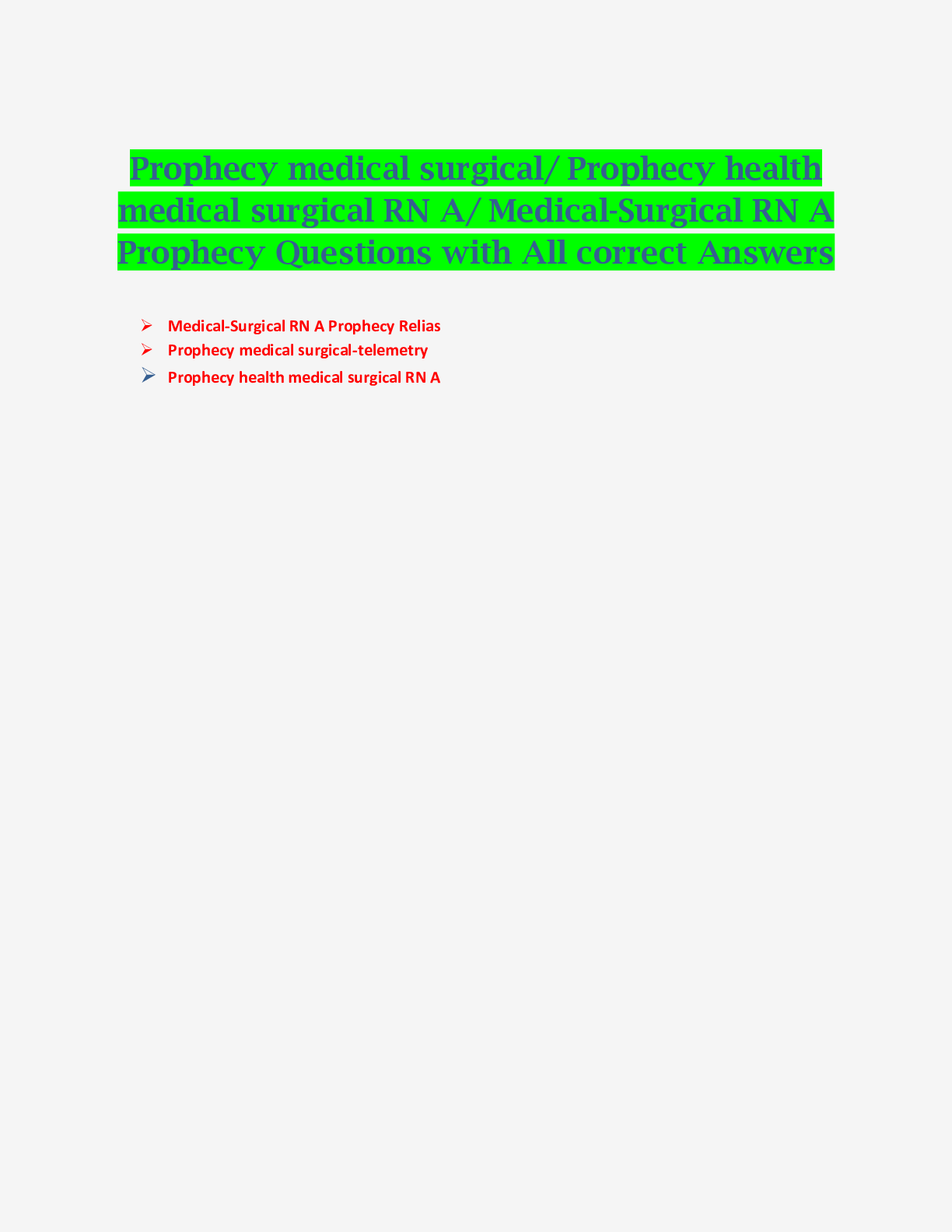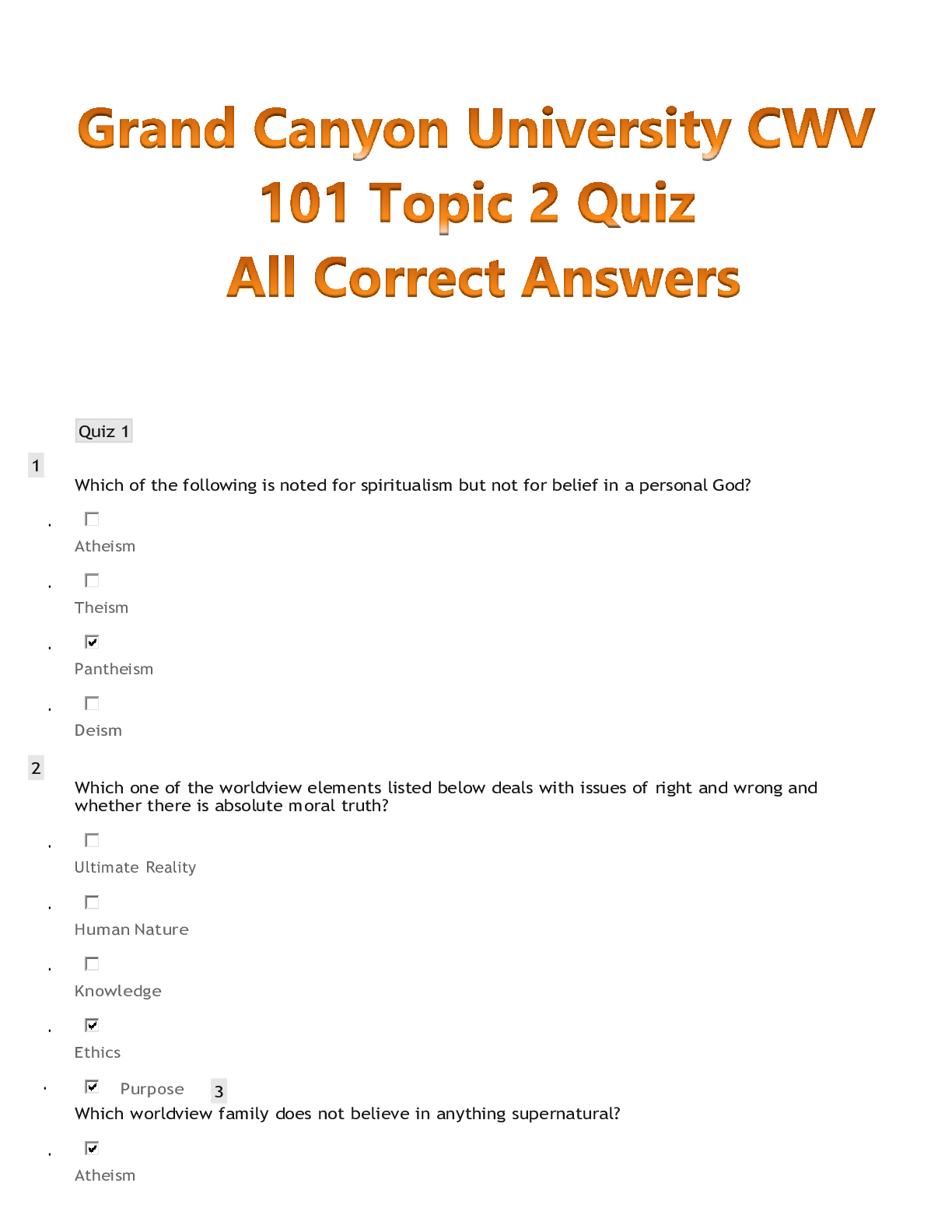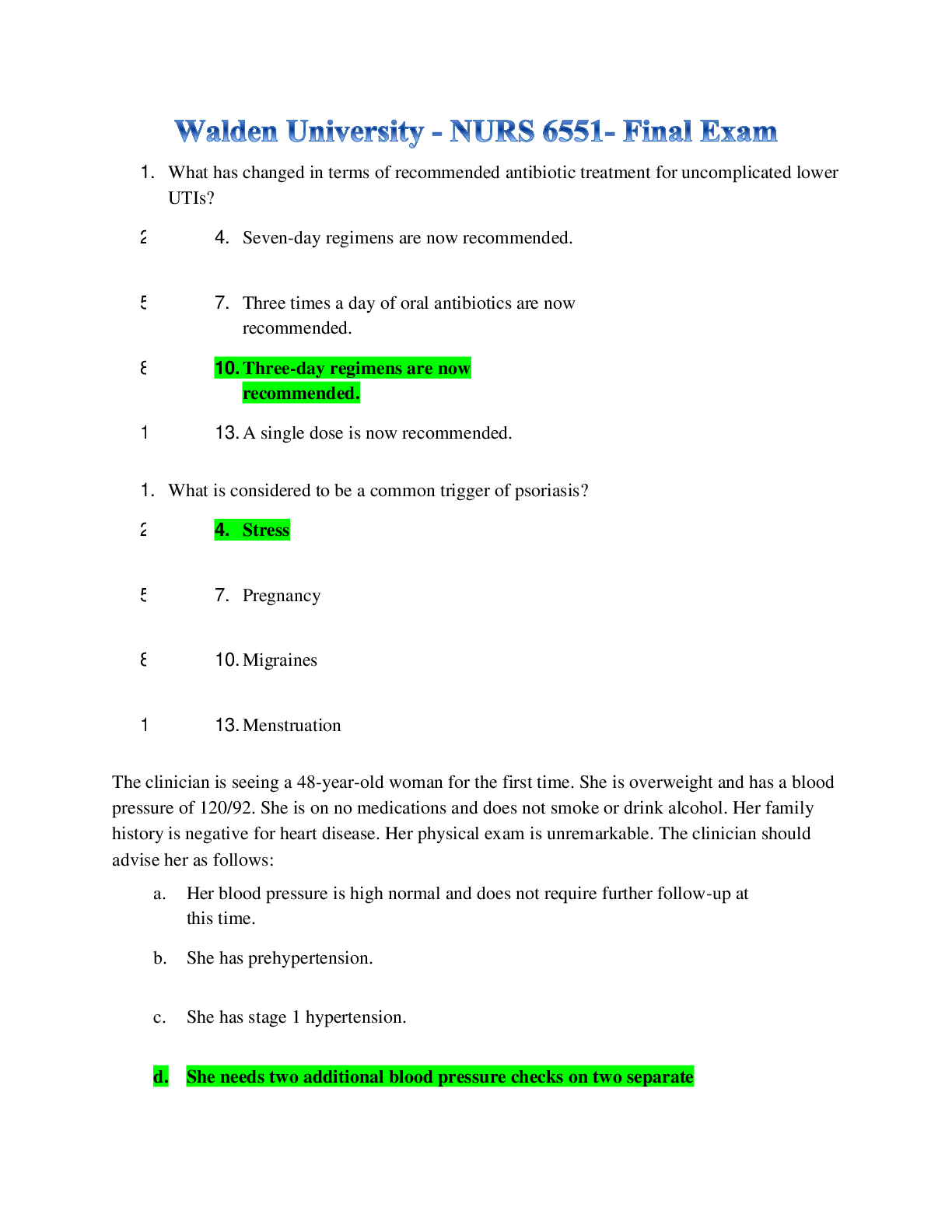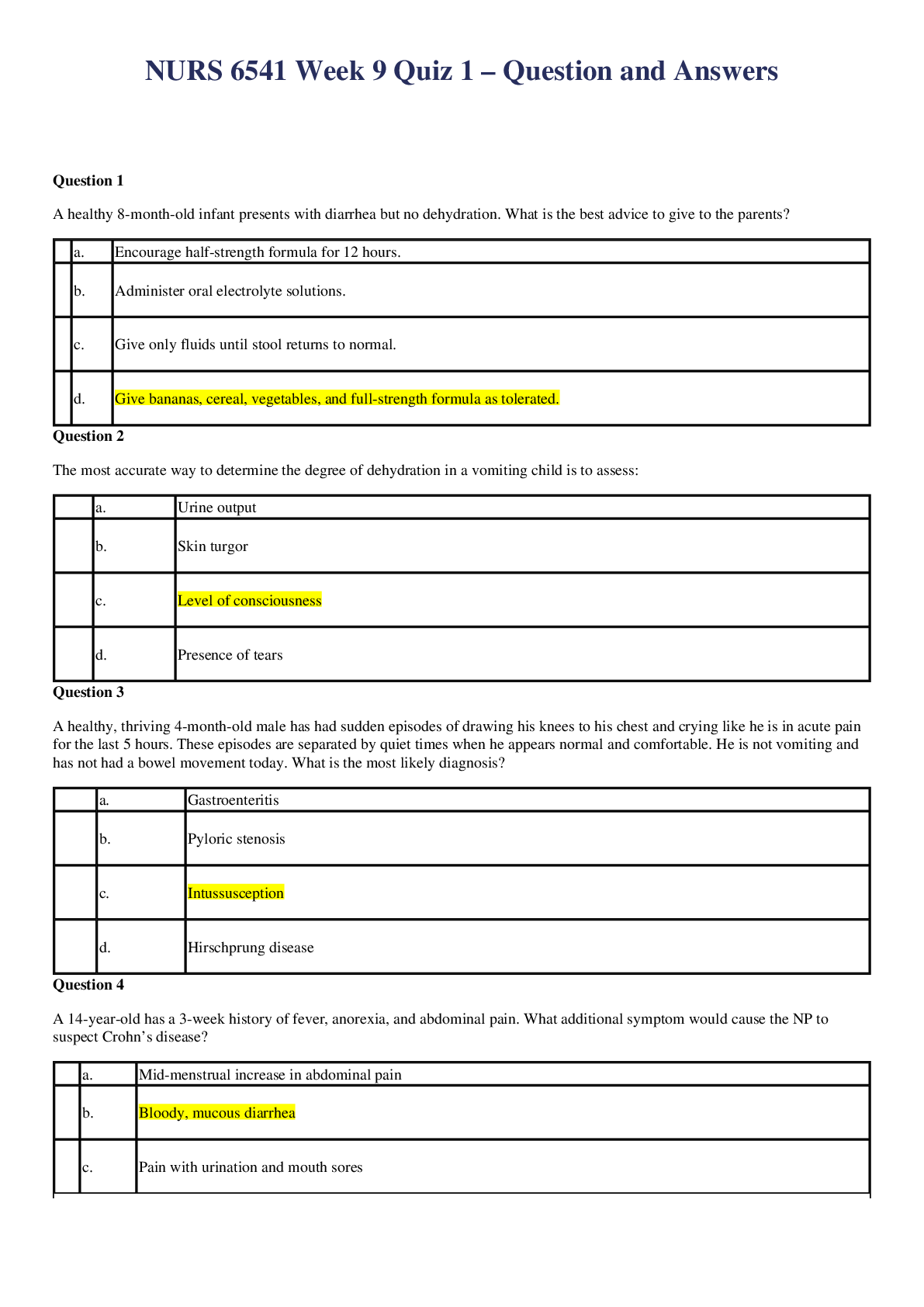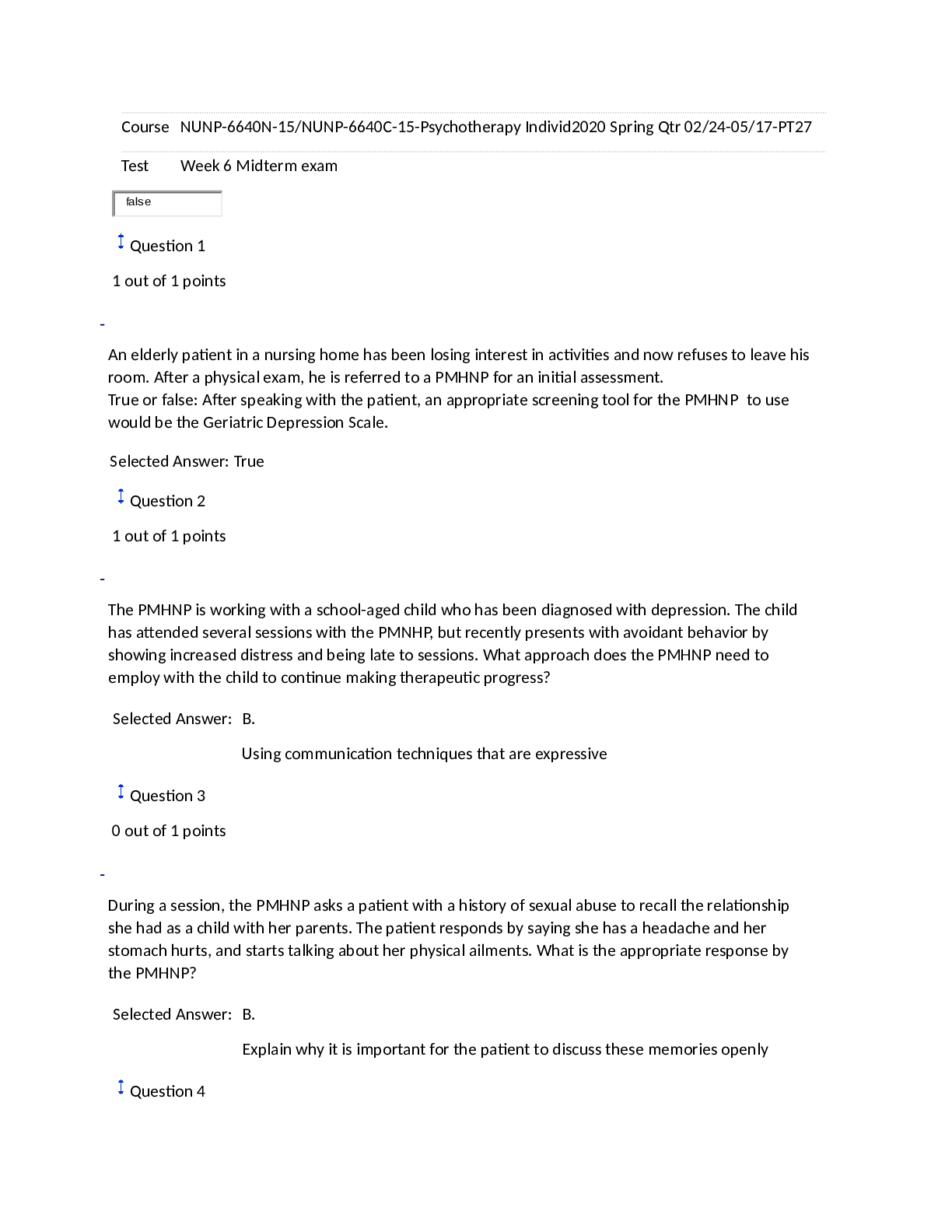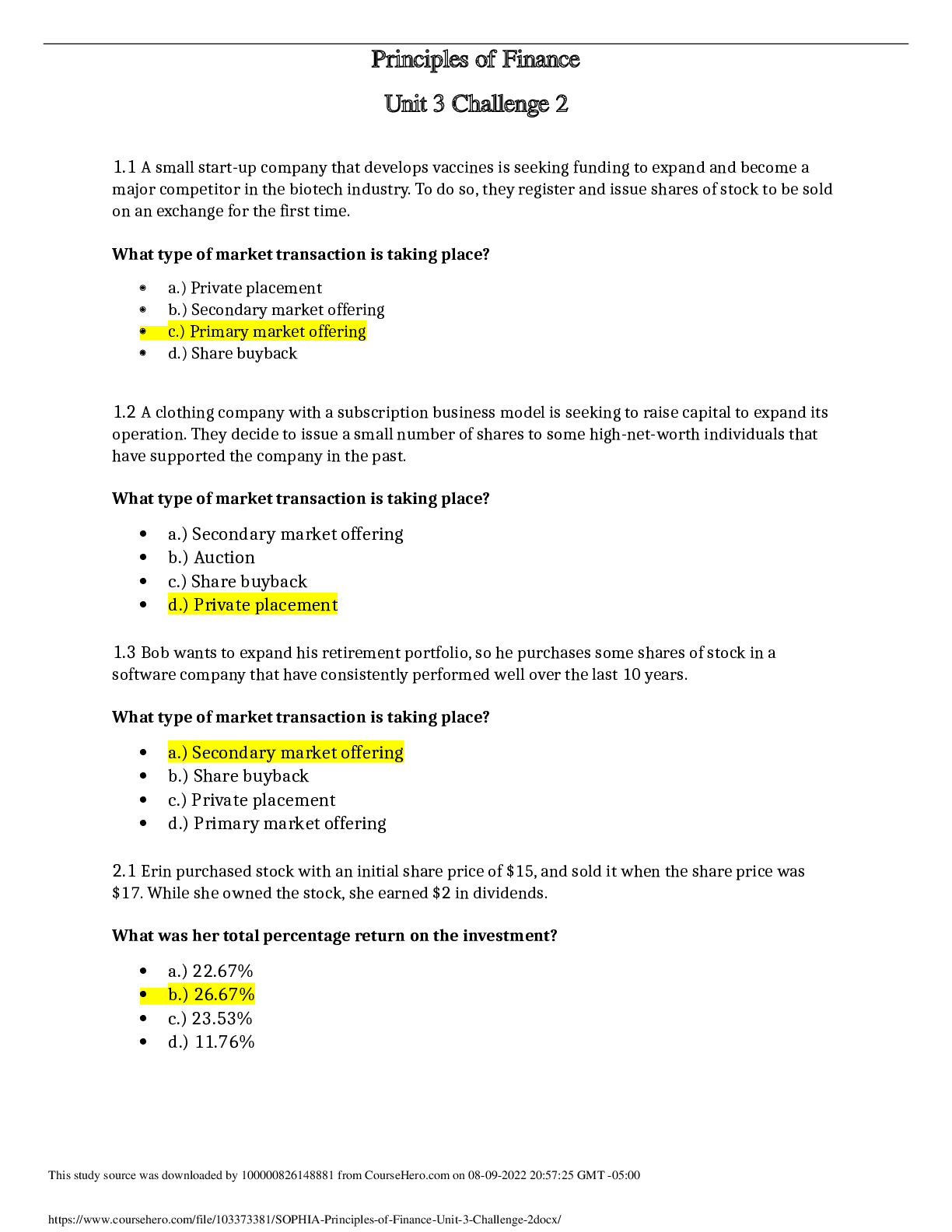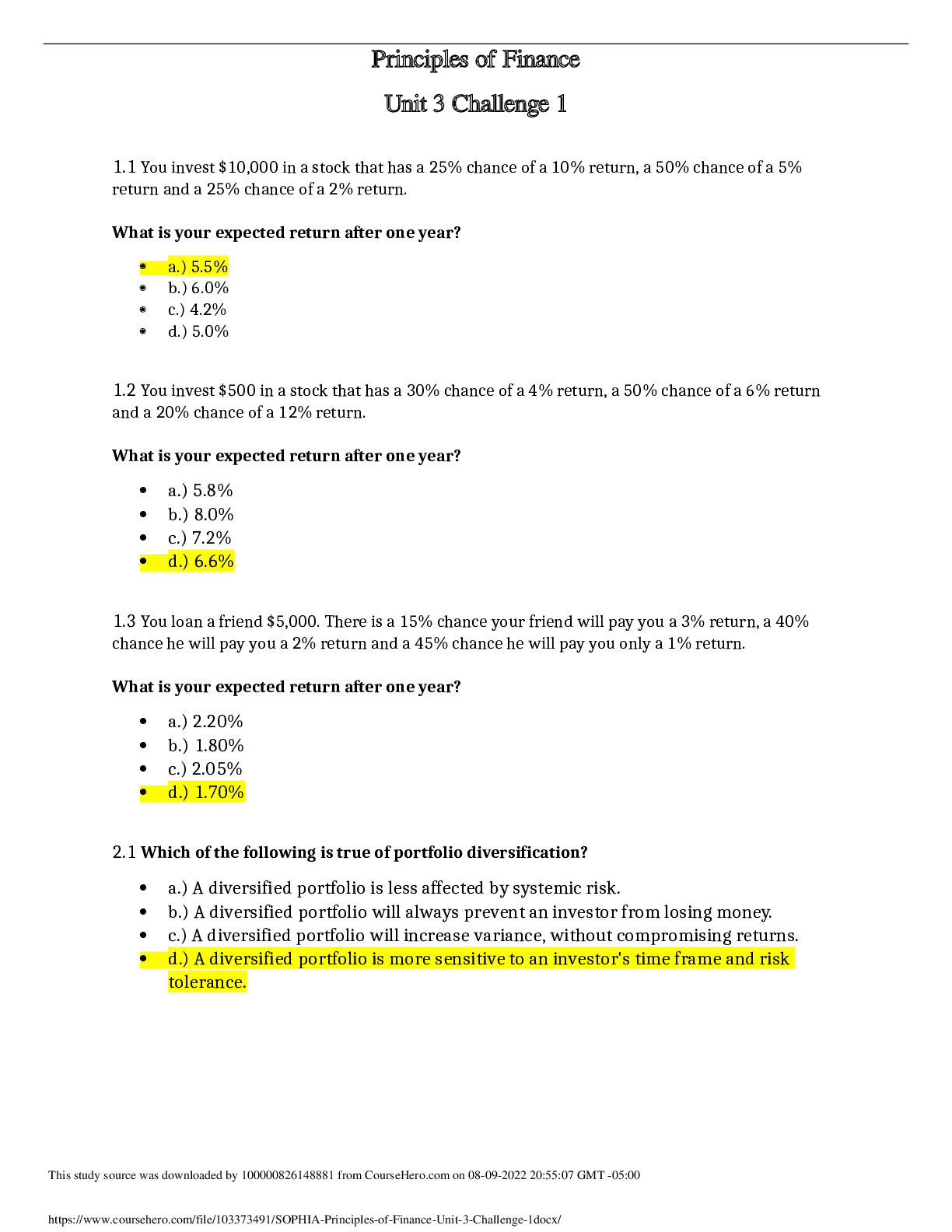NURS 6660 Exam Mid Term. Walden University - All Correct Answers
Document Content and Description Below
Walden University - NURS 6660 Exam: NURS 6660 Mid Term Jack is a 3-year-old boy who is being evaluated for developmental delay. The mental status examination is significant for an inability to stack ... two blocks or draw a circle. The PMHNP also appreciates the inability to attend to any task for more than a few seconds. These findings indicate an abnormality in: A. Social relatedness B. Thought process and content C. Motor behavior D. Judgment and insight During the mental status exam of Oliver, a 4-year-old child, the PMHNP appreciates that he appears to be having transient visual and auditory hallucinations. The PMHNP knows that the best approach to this finding is to consider that: A. This is most consistent with early-onset schizophrenia B. An organic brain disorder should be ruled out C. These are normal findings in very young children D. Comprehensive psychiatric assessment is indicated Jason is a 17-month-old male who is referred for evaluation of an unusually high level of irritability. His mother says he cries “all the time,” and sometimes he just cannot be comforted; Jason’s pediatrician felt that the complaint warranted an evaluation by child psychiatry. Comprehensive assessment of Jason’s irritability should include all the following except: A. A comprehensive medical assessment B. Standardized developmental measures C. Assessment without the parents present D. Observation of Jason during play Which of the following is the most common anxiety disorder of childhood? A. Generalized anxiety disorder B. Separation anxiety disorder C. Social anxiety disorder D. Obsessive-compulsive disorder When evaluating treatment strategies for a 14-year-old patient with obsessive-compulsive disorder (OCD), the PMHNP considers that evidence-based data from the Pediatric OCD Treatment Study (POTS) suggests that best outcomes are achieved with cognitive behavioral therapy (CBT) and: A. Clomipramine (Anafranil) B. Sertraline (Zoloft) C. Aripiprazole (Abilify) D. Lithium (Eskalith) Which of the following behaviors is least suspicious for an adolescent who is being bullied at school? A. A significant change in study habits in which the patient is demonstrating higher academic achievement to the exclusion of a social life B. A persistent, sustained increase in the number and variety of physical complaints that have no obvious organic cause C. Evidence that the patient has started smoking cigarettes and seems to spend more time alone than usual D. Migration to a completely different peer group and a change in appearance and behavior to aggressively mimic the new group Michael is a 13-year-old boy who was involved in a traumatic automobile accident in which his mother, the driver, was killed. After suffering multiple injuries and weeks in the hospital, Michael was discharged to home with physical therapy. He ultimately made a complete physical recovery but is unable to get into a car. Just the thought of riding in a car produces profound physiologic symptoms. He has been diagnosed with post-traumatic stress disorder (PTSD). His avoidance of riding in a car is conceptualized as: A. Panic attacks B. Operant conditioning C. Hyper arousal D. Flashbacks Which of the following is a true statement with respect to developmental testing in infants? A. None of the available validated developmental tools are reliable in infants under 6 months of age. B. An infant’s score on developmental assessment is a reliable predictor of future intelligence quotient. C. Infant assessments are helpful in detecting mental retardation and developmental disorders. D. Assessment in older infants focuses on sensorimotor and social responses. Wendy is a 6-year-old female being evaluated by the PMHNP following a suicide attempt. The police were called when a neighbor saw Wendy jump out of the open window of her first-floor apartment. She was unhurt, but when the neighbor asked why she jumped out she said she wanted to kill herself. Which coincident finding would warrant an inpatient psychiatric admission for Wendy? A. This was not the first episode. B. The caretaker is incapable of arranging follow-up. C. One or both of the biological parents has a history of suicide attempts. D. Wendy was left with a babysitter when the incident occurred. Caleb is a 10-year-old boy who is referred for assessment because he is not following any of the rules of discipline at home. His parents report that they have had three separate nannies resign in the last 4 months because Caleb is unmanageable. This is a long-standing problem, going back to daycare even before kindergarten. The PMHNP knows that when conducting her initial interview of Caleb she should: A. Anticipate that he can tolerate up to a 45-minute session B. Consider that symbolic play with dolls will be informative C. Interview him alone before involving the parents D. Be clear that he is there because of problem behavior Treatment of abused children is multimodal and long term. The single most important aspect of treatment is: A. Establishing a safe place for the child B. Exposure related to the feared experience C. Psychoeducation D. Cognitive-behavioral interventions Psychiatric assessment of the adolescent patient is different in several ways from assessment of younger children. While trying to establish a therapeutic environment with an adolescent who is openly hostile, one of the most important things the PMHNP can do is to: A. Be more liberal in terms of limit setting and tolerating hostility in order to facilitate honest communication B. Ensure the patient that under no circumstances will anything said be repeated to the parents C. Allow silences to last as long as necessary until the patient is inclined to offer any verbal input D. Communicate to the patient that his or her perspective is valued and will not be judged or critiqued A variety of questionnaires, scales, guided-interview tools, and other standardized instruments are available to aid with various aspects of assessment. The majority are intended only to be used as an aid to information gathering and not to make a diagnosis. Which of the following tools requires training to administer and can be used to determine diagnoses? A. Child and Adolescent Psychiatric Assessment (CAPA) B. Brief Impairment Scale C. Pictorial Instrument for Children and Adolescents (PICA-III-R) D. Achenbach Child Behavior Checklist The PMHNP is drafting a proposal for research funding for a project to offer primary prevention strategies designed to reduce the incidence of bullying. In support of this project, the PMHNP provides data supporting the fact that both perpetrators and victims of bullying suffer all of the following except: A. Higher incidence of emotional problems B. Greater difficulty making friends C. Poorer academic achievement D. Increased percentage of smoking Which of the following manifestations of childhood anxiety disorders is considered a psychiatric emergency? A. School refusal B. Bedtime refusal C. Eating refusal D. Speech refusal The PMHNP is performing an assessment on Julie, a 4-year-old girl who has been brought to care by her mother. The mother was referred by the pediatrician because Julie has been demonstrating an appreciable change in her behavior. She is developmentally on target and has always been a happy and curious child, but for the last few months she seems to be much more fearful and anxious. Which of the following recently acquired behaviors described by the mother is most suspicious for sexual abuse? A. Prolonged periods of daydreaming B. Masturbating with a toy C. Touching the genitals of her 3-year-old cousin D. Showing her genitals to other children at daycare What is the primary diagnostic difference between obsessive-compulsive disorders in children as compared to adults? A. Age of onset B. Response to treatment C. Recognition that the thoughts or behaviors are irrational D. The thoughts or behaviors occupy > 1 hour daily With respect to treatment of conduct disorder, the PMHNP knows that: A. The reduction of violence and aggression in school is critical B. Parental psychiatric intervention has not demonstrated improved outcomes C. Atypical antipsychotics are avoided due to the adverse effect profile D. Treatment with psychostimulants exacerbates aggressive behaviors Kelly is a 13-year-old girl who is being evaluated because her parents are very concerned about her sudden disinterest in school. She does not want to go to any social activities and her grades have dropped markedly in the last several months. When considering bullying as a cause of her behavior change, the PMHP considers that which type of bullying is more common among girls? A. Verbal B. Physical C. Relational D. Cyber Karen is a 7-year-old girl who has been started on atomoxetine 18 mg once daily for ADHD, which is just under the recommended starting dose of 0.5 mg/kg/day. After just 1 week, her parents report that she is not eating, complains of stomach pain almost every day, is having trouble sleeping, and is “really cranky.” Her teacher says she never seen anything like it; that Karen is actually worse on her ADHD medication. A careful review reveals that Karen is taking her medication just as prescribed. She is not on any other prescribed, over-the-counter, or herbal medications. The PMHNP considers that: A. These are common in the first weeks of therapy and the dose should be increased to a therapeutic regimen B. Karen may be a poor metabolizer of CYP2D6 medications and will need a change of therapy C. Behavioral modalities should be started as optimal management of ADHD is multimodal D. Fluoxetine should be added to the regimen as it has demonstrated efficacy with coincident anxiety Carolyn is a 14-year-old female who is in care because she has developed increasingly difficult behavior at home and school. She is inappropriately dressed for the interview, wearing heavy makeup and conducting herself in a suggestive manner. Her medical history is significant only for childhood asthma and four urinary tract infections in the last year. Carolyn’s mother reveals that Carolyn’s stepfather has a history of sexually abusing his biological daughter, and the mother is beginning to wonder if something isn’t “going on” in her own home. Carolyn vigorously denies this, and indicates that her stepfather is very good to her, takes care of her, and is her “best friend.” The PMHNP recognizes that Carolyn may be in which phase of intrafamilial sexual abuse? A. Engagement B. Secrecy C. Disclosure D. Suppression Phillip is a 5-year-old boy who is in care after being referred for failure to speak at school. He has been in kindergarten for 5 months, and initially his teacher thought he was just shy, so she did not focus on him. However, it has become increasingly apparent that he flat out will not speak at school. Phillip’s parents are adamant that there is not any problem at home and that Phillip talks with them and his older sister routinely. Further assessment reveals that he has always been extremely shy and that he doesn’t like it when people make a fuss over him. The PMHNP suspects that Phillip has selective mutism, which is closely related to: A. A history of sexual abuse B. Fetal alcohol syndrome C. Early onset schizophrenia D. Social anxiety disorder With respect to psychiatric assessment, the PMNHP knows that in terms of confidentiality: A. All information related to a minor may be shared with the parents without the child’s consent. B. Whenever there is a suspicion of neglect or abuse, the appropriate state agency must be notified. C. Every state has laws that emancipate children for issues of mental health. D. All children are entitled to confidentiality unless they are a danger to themselves or others. The PMHNP is performing a series of court-ordered home visits to evaluate concerns about a 4-month-old infant who presented for a well checkup with clear failure to thrive. While observing the mother’s interaction with the infant, the PMHNP notes a negative pattern of interaction. This is characterized by: A. The child refusing to feed and the mother feeling rejected and withdrawing B. The mother not holding the child during feeding and the child withdrawing C. The mother not responding to hunger cues, e.g., crying, and the child stopping demonstrating them D. The mother being overly protective and trying to feed excessively, and the infant stopping eating The PMHNP observes separation from and reunion with the parent as part the mental status exam of a 25-month-old toddler. Extremes of emotion during separation or reunion are most consistent with: A. Normal developmental progression at that age B. Cognitive dysfunction C. Neurologic dysfunction D. Problems with the parent-child relationship The PMHNP is reviewing assessment data on Richard, a 14-year-old boy who was brought in for evaluation by his parents. He has a longstanding history of being difficult, defiant, and argumentative with adults. While considering differential diagnosis of oppositional defiant disorder and conduct disorder, which of the following findings meet criteria for conduct disorder? A. Openly defies rules, argues with adults, is truant from school B. Shoplifts valuable jewelry, is persistently angry and resentful, runs away from home C. Often loses temper in the classroom, upturned a desk at school in anger, is verbally cruel to classmates D. Has a history of physical cruelty to the family cat, broke into the neighbors’ house while they were on vacation, starting fist fights at school Melanie is a 13-month-old female who has been referred by her primary care pediatrician. She has not had consistent well-child checks, and at her first visit with this pediatrician at age 1 year, there was a notable absence of verbal babbling, interactive play, or smiling. Comprehensive assessment of Melanie must include all the following except: A. The Children’s Apperception Test (CAT) B. A comprehensive history C. A mental status examination D. Neuropsychiatric assessment Despite a wealth of data-based information on bullying, including information about its forms, presenting symptoms, and consequences, current research suggests that accurate information about bullying is not influencing preventive and awareness strategies in most school systems. When advising school personnel, parents, and primary care providers about bullying, the PMHNP should emphasize that: A. Physical bullying has the most dangerous outcomes B. Bullying is more common in boys than girls C. Victims often develop alcohol abuse problems D. Verbal bullying is the most common form Minor physical anomalies, such as high-arched palate, low-set ears, and transverse palmar creases, occur in a higher than average distribution in children with all of the following except: A. Learning disabilities B. Speech and language disorders C. Hyperactivity D. Delayed puberty Comprehensive psychiatric assessment of young school-aged children requires a variety of information sources. Input is necessary from parents, caregivers, and teachers because children of this age group cannot reliably provide information about: A. Their own fears and anxieties B. Psychotic episodes they have experienced C. The chronology of symptom presentation D. Episodes of mood extremes Mark is a 5-year-old boy brought in for evaluation because his behavior at school has become so disruptive. According to the parents, Mark’s teacher says he just refuses to follow the rules of the classroom, openly defies her, and actually seems to try and upset his classmates. The teacher says Mark gets frustrated very easily when he cannot complete a task and is resistant to any effort to help him. This happens almost every day, and the teacher has indicated that she will not be able to keep him in the classroom if things do not change. Mark’s parents admit that he has always been “willful” and difficult to manage, but as he is an only child with a stay-at-home mom, the family overlooked his disruptive tendencies and accommodated Mark. The parents report that they often skip social events and family outings because they don’t know how Mark will behave. While counseling Mark’s parents about the theories of causation of oppositional defiant disorder (ODD), the PMHNP tells the parents that psychiatric theories include all of the following except: A. Unresolved conflict as a fuel for aggressive behavior targeting authority figures B. The concept that oppositionality is a reinforced, learned behavior in which the child exerts control over authority figures C. A maladaptive response to parents’ modeling of conflict avoidance as manifested by even-tempered responses to parent-toddler struggles D. That the behavior is reinforced by increased parental attention in response to the undesirable behavior Having child and adolescent patients rate their feelings and moods on a scale of 1–10 is most effective in which age group? A. 18-months to 3 years B. 3 to 5 years C. 5 to 11 years D. 12 to 17 years Which of the following is a true statement with respect to conduct disorder? A. The diagnosis is distributed equally between boys and girls. B. Boys with conduct disorder are more likely to develop somatic symptoms later in life. C. About 80% of children with conduct disorder were previously diagnosed with oppositional defiant disorder (ODD). D. The later the age of onset of conduct disorder, the greater the risk of antisocial personality disorder (ASPD) in adulthood. Being Brave: A Program for Coping With Anxiety for Young Children and Their Parents is a manualized intervention for anxiety disorders in young children between the ages of 4 and 7 years old. It uses a combination of parent-only and parent-child sessions and demonstrates significant improvement in children with all forms of anxiety disorders except: A. Separation anxiety B. Social anxiety C. Generalized anxiety D. Specific phobia Eric is an 11-year-old male for whom an emergency assessment was requested due to fire-setting. This is not Eric’s first fire, and his parents admit that he has had a bit of a fixation with the fireplace and matches for a few years. During the evaluation, the PMHNP should be particularly alert to other findings consistent with: A. Childhood schizophrenia B. Bipolar disorder C. Sexual abuse D. Conduct disorder Which of the following is a true statement with respect to crisis intervention and psychological debriefing as a preventive strategy for post-traumatic stress disorder (PTSD)? A. Crisis intervention and psychologic debriefing is most effective if it occurs within 24 hours of the event B. The focus of crisis intervention and psychologic debriefing is management of emotional reactions C. Psychoeducation is not typically a component of crisis intervention and psychologic debriefing D. No controlled studies support that crisis intervention and psychologic debriefing improves outcomes Which of the following is not a true statement with respect to theorized etiologies of ADHD? A. Psychosocial factors do not appear to contribute to the development of ADHD. B. Some literature suggests that prenatal exposure to winter infection during the first trimester of pregnancy leads to ADHD C. Biological parents of children with ADHD have a higher incidence of the disorder than adoptive parents D. Overall, no clear-cut evidence supports a single neurotransmitter in the development of ADHD The clinical interview is an important part of psychiatric assessment and should be conducted early in the diagnostic process. However, a comprehensive assessment should include other information-gathering modalities because the clinical interview: A. Does not offer flexibility in understanding the evolution of the problem B. Frequently deemphasizes the influence of environmental factors C. May not systematically cover all psychiatric diagnostic categories D. Creates a dialogue in which patients cannot give subjective responses e PMHNP is evaluating a 15-year-old male patient who has been referred by his court-appointed guardian. He has been in foster care for the last 6 years and maintained a steady pattern of low-level behavior problems such as skipping school and ignoring curfew. He is not openly defiant and has always been described as a “loner.” He just does not follow most rules. During the mental status examination, the PMHNP notes that his expressions are sometimes inconsistent with the topic of conversation, and he does not seem to be able to transition effectively among levels of emotion. This represents an abnormality in: A. Mood B. Affect C. Thought process and content D. Judgment and insight Kevin is a 15-year-old male who presents for court-ordered psychiatric assessment. Kevin comes to his first appointment with both of his parents. He is sitting in the chair with his arms crossed and responds with “yes” and “no” answers to direct questions; otherwise, he volunteers no information. The parents are clearly upset and indicate they just “don’t know what to do with him anymore.” The most appropriate action for the PMHNP would be to: A. Ask the parents to step out and interview Kevin privately B. Have Kevin complete a standardized-testing assessment C. Schedule session two after reviewing court documentation D. Arrange for three sessions with a family therapist then reevaluate Kevin Which of the following statements is true with respect to children who present to care acutely due to violent, enraged behavior? A. Under no circumstances should the PMHNP approach this patient. B. Prepubertal children typically require medication as they are too young to respond to conversation. C. Children who have a history of repeated, self-limited, severe tantrums require at least a 72-hour admission. D. If the child appears to be calming down in the emergency area, the clinician may ask the child for his version of events. Comprehensive psychiatric/mental health assessment of children includes an interview with the parents or caregivers. Which of the following is not a true statement with respect to the parental interview? A. The parents’ own emotional adjustments should be determined. B. The parents are usually more aware of symptoms than the child. C. The parents may prefer to speak with the PMHNP separately. D. The parents’ upbringings are relevant to the child’s diagnosis. The PMHNP is evaluating his data for the assessment of Eric, a 23-month-old male who was referred because he is having nightmares to the extent that most nights he is waking up family members with his crying and screaming. In addition to the clinical interview with the parents and patient, developmental assessment, and standardized tools, the assessment should include: A. Review of a video recording of a nightmare event and Eric’s immediate response B. Age-appropriate interview, e.g., “If you had three wishes, what would they be?” C. Observation of Eric in a playroom where he is unaware that he is being watched D. Partially open-ended questions that provide some focus but allow expression of feeling Sarah is a 10-year-old patient who has been diagnosed with oppositional defiant disorder. While discussing the diagnosis, course and prognosis, and treatment strategies with Sarah’s mother, the PMHNP emphasizes that successful management of oppositional defiant disorder (ODD) must include: A. Parent training B. Pharmacotherapy C. Time out D. Conflict avoidance Management of a child who has a pattern of fire-setting behavior must include: A. Combination therapies that include medication with an SSRI B. Parental counseling that the child should never be allowed home alone C. Inpatient admission for intensive individual and group therapy D. Behavioral interventions characterized by negative reinforcement The PMHNP is discussing autism spectrum disorder (ASD) treatment strategies with the parents of 4-year-old Jeffrey. He is nonverbal and has been completely unable to adapt to any changes of environment; an effort to put him in a preschool class was what precipitated his evaluation and eventual diagnosis. At this point, Jeffrey’s parents are very committed to doing anything necessary to support Jeffrey’s growth and development and promotion of prosocial behavior. While developing his plan of care, the PMHNP suggests: A. Structured classroom training with consistent behavioral programs B. Facilitated communication with a computer or letter/picture board C. A trial of escitalopram daily to promote decreased irritability D. An atypical antipsychotic as needed to decrease self-injurious behavior Justin is a 3½ -year-old boy who comes in with his mother. She is concerned that he has obsessive-compulsive disorder (OCD). Justin’s mother says that her husband has struggled with OCD all his life; he was first diagnosed when he was 11 years old thanks to an alert teacher who suggested mental health care. Justin’s mother has been very proactive in studying genetic risk, and she knows that Justin is at significantly increased risk due to the early-onset in his father. Which of the following behaviors by Justin would be most consistent with OCD? A. Clear social difficulties in addition to an apparently unusual need for cleanliness and order in his bedroom B. Refusal to go to bed without his blue stuffed elephant; this began over a year ago and is getting progressively worse C. Insistence upon precise placement of plate, cup, utensils and food on plate when eating; when he cannot achieve this, he will not eat D. A concomitant diagnosis of ADHD for which the family is currently in behavioral therapy The PMHNP is evaluating 12-year-old Dale after the police were called to the home. Dale is assessed as having a psychotic episode; he tells the NP that voices are telling him that he is bad and that he should hurt himself. According to the mother, he has no history of psychiatric disease, medications, or really any concerns at all. Mom says he goes to school, has friends, and has always seemed “normal.” An interview with his 13-year-old sister reveals that while there is no long-term history of abnormal behavior, for the last couple of weeks things have been very strange at home. His father has been arrested for “something to do with a teenage girl,” and their parents have been fighting. His father lost his job, and there is a lot of talk about money and lawyers and jail. Dale has been very emotional as he has always been close to his Dad; he seems to go from crying to laughing in a blink, and is getting in fights at school. Even now, after he has calmed a bit, Dale’s reality testing is altered. The PMHNP considers that Dale is demonstrating: A. Symptoms of childhood schizophrenia B. A manic episode C. Brief psychotic disorder D. Intermittent explosive disorder Trauma-focused cognitive behavior therapy is a CBT approach characterized by 10–16 sessions comprised of four components: (1) psychoeducation, (2) stress inoculation, (3) gradual exposure, and (4) cognitive reprocessing. This is a management strategy for post-traumatic stress disorder (PTSD) that is: A. Most effective when paired with eye movement desensitization and reprocessing (EMDR) B. Considered by experts to be the first-line management approach for treatment of PTSD symptoms C. Very effective in individuals but generally not recommended for group treatment, e.g., school-based traumas D. Gaining widespread acceptance as a first-line management strategy for other forms of anxiety disorders The PMHNP is providing counseling for the family of a 6-year-old girl who was recently adopted. This girl reportedly was removed from a home in which she was subjected to severe, long-term abuse in all forms: neglect, physical abuse, sexual abuse, malnutrition, and neglect of all medical care. Upon her rescue, which was incidental during a drug raid on the home, she was hospitalized for over 1 month for physical maintenance, nutrition, hydration, and treatment for a variety of infections, including sexually transmitted diseases. The adoptive family is very committed to providing a healthy environment and is very receptive to long-term individual and family therapy. The PMHNP discusses with the new parents and siblings that which of the following is most often linked to this type of history: A. Dissociative disorders B. Negative attachment C. Aggression toward siblings D. School refusal Children who have been subjected to maltreatment will frequently demonstrate a variety of behavioral and psychologic symptoms, including increased aggressiveness, heightened autonomic arousal, and memory problems. Neurobiologic explanations suggest that this may be due to: A. Scarring of the hippocampus B. Hypertrophy of the corpus callosum C. Limbic suppression D. Decreased integration of left and right hemispheres Evaluation of psychiatric emergencies in children must include: A. A complete physical examination B. Psychiatric disorders in family members C. A comprehensive toxicology screen D. Interviews with teachers and noncustodial caretakers Susan is a 10-year-old girl who has been referred by her pediatrician for mental health evaluation due to a persistent collection of somatic symptoms for which there is no apparent organic cause. For the last 2 months Susan has been increasingly distraught at the prospect of leaving home. This has become very apparent since the start of the school year. She often develops stomachaches and headaches when it is time to go to school. Lately she does not want to go to bed unless her mother remains upstairs. The PMHNP considers a diagnosis of: A. Separation anxiety disorder B. Social anxiety disorder C. Generalized anxiety disorder D. Social phobia disorder While evaluating Jennifer, a 32-month-old female, for autism spectrum disorder (ASD), the PMHNP conducts a detailed assessment, including a medical history of both the patient and all first-degree family members. This is critically important as the most common known cause of ASD is: A. Fragile X syndrome B. Advanced maternal age C. Autoimmune disease in > 2 first-degree family members D. Being raised in a single-parent home during the first year of life The PMHNP has been retained by the local school board to provide comprehensive counseling and guidance following an episode of tragic school violence. A 9th grader, acting alone, brought a gun into the school, fatally shooting a teacher and injuring four other teachers and students before he was subdued. In an effort to promote best healthy practices after this traumatic event, the school board is asking for advice on how to best manage the students. The PMHNP knows that the immediate priority must be: A. Returning to normal routine immediately B. Development of peer counseling groups C. Establishing the perception of safety D. A memorial service to process the loss Comprehensive psychiatric assessment ultimately requires the integration of biological predisposition, psychodynamic factors, environmental factors, and life events. These factors, along with a mental status exam, developmental assessment, and any appropriate standardized testing is collectively referred to as: A. Neuropsychiatric assessment B. Biopsychosocial formulation C. The Physical and Neurological Examination of Soft Signs (PANESS) D. Kaufman Assessment Battery for Children The PMHNP is performing an emergency assessment on Renee, a 9-year-old girl who was initially brought to the attention of social services by her maternal grandmother. Renee is reluctant to talk about herself or her home life. The physical examination that accompanied this emergency assessment revealed a variety of ecchymoses in various stages of healing, and the examiner was suspicious that there was a history of sexual abuse. Renee is quiet and passive during the interview, but is rather aggressive when playing with dolls. While considering the need for removal from the home, the PMHNP knows that all the following are risk factors for predictors of further abuse and maltreatment except: A. Neglect as the form of maltreatment B. Parental conflict C. Number of previous episodes D. Gender of the victim Harmony is a 4-year-old female who has been through several evaluations for behavioral abnormalities that have become increasingly disruptive, and the family is concerned for the safety of both Harmony and her 2-year-old brother. Comprehensive assessment of Harmony includes neuropsychiatric testing. The PMHNP documents the presence of neurological hard signs. These suggest: A. Brain lesions B. Early-onset schizophrenia C. Low intelligence D. Learning disability The PMHNP is preparing an educational program for primary care providers about child abuse awareness. The goal of the program is to increase the understanding of primary care providers regarding risk factors for child abuse so that at-risk families may be identified and primary preventive strategies implemented before any harm occurs to children. The program emphasizes risk factors for child maltreatment to include all of the following except: A. Single-parent families B. Low parental education C. Parental substance abuse D. Firstborn child in the family Kristina is a 17-year-old female who was encouraged to care by her parents because they have been worried about her. She has always been very healthy, happy, and active in school and sports. Her boyfriend of three years broke up with her last fall, right before he left for college. Since then she has lost all interest in her friends and school. Her parents say that she doesn’t do anything after school except go to her room. She has lost 16 pounds in the last 9 months. During the second session with the PMHNP, Kristina insists that her parents are overreacting, that she is doing OK in school and is eating just fine. She says of course she was sad that her boyfriend broke up with her, but she has gotten over it and moved on. During this session, the PMNHP appreciates that Kristina’s clothes are clearly too big for her, her eyes fill up with tears whenever her boyfriend is mentioned, and she does not seem engaged in the interview. While considering her assessment, the PMHNP recognizes that: A. The absence of a remote history of psychiatric disease makes a true psychiatric diagnosis unlikely B. The PMHNP must prioritize Kristina’s subjective report versus her parents’ report C. A standardized assessment tool such as the Patient Health Questionnaire (PHQ)-9 will be required for diagnosis D. The objective signs evident in Kristina’s examination are more compelling than her perspective on symptoms Mrs. Jacobs has accompanied her son to today’s session. Her son is in psychiatric care because he has developed disciplinary issues and for the last several months has been challenging authority, truant from school, and openly defiant of the household rules. Mrs. Jacobs is understandably distraught and is adamant that her son must be the victim of bullying because yesterday he came home from school with a black eye and a swollen lip. While this has never happened before, she believes that bullying is the only explanation for his behavior at home. While counseling Mrs. Jacobs about bullying, the PMHNP emphasizes that, by definition, bullying: A. At some point will always involve physical aggression B. Does not occur unless more than one aggressor participates C. Is always unprovoked and intentionally cruel D. Rarely results in permanent, irreversible physical harm Jenny is a 5-year-old female who has been referred for consultation because the emergency room physician suspects that she might be subject to physical abuse in the home. On evaluation, the PMHNP finds Jenny to be fearful, docile, and guarded. Although clearly in pain, Jenny seems surprised when the PMHNP attempts to provide some comfort. The PMHNP notes that: A. If Jenny demonstrates abnormal attachment with her mother, this will complete textbook criteria for symptoms of physical abuse B. There must be a consistent pattern of atypical physical injury to support the diagnosis of physical abuse C. Jenny’s behaviors are more consistent with sexual abuse than physical abuse D. These same symptoms may occur in the absence of any abuse and are neither specific or pathognomic for abuse John is an 11-year-old male being evaluated for conduct disorder. His history is significant for setting fires in his neighbor’s garage, repeated episodes of truancy for the last 2 years, and three separate episodes of running away from home beginning when he was 8 years old. His teacher has reported that he is quite adept at manipulating his peers to get what he wants, and he has tried to do the same thing to her. His parents deny any concerns about anger. They are having a hard time believing that there is a problem because while John has a tendency to pursue dangerous activities, it seems more like it is just because he is bored. During interview, John does not seem at all hostile or angry. Like his parents, he does not really seem to think anything is wrong. Which of John’s findings implies the greatest risk factor for severe, persistent conduct problems? A. The fire setting B. Running away beginning at age 8 C. His lack of guilt D. Truancy prior to age 10 The PMHNP is evaluating the data he has collected in the assessment of Anna, a 9-year-old girl who presented for evaluation because her teacher strongly encouraged Anna’s mother to seek care. According to the teacher, Anna has been consistently disruptive in the classroom since the beginning of the school year, 2 months ago. The assessment includes unstructured interviews with Anna, her mother, and grandmother, and Connors Parent or Teacher Rating Scale for ADHD completed by her primary school teacher and mother. The PMNHP notes a marked disparity among reports—they all seem to contradict each other. The PMHNP considers that this apparent contradiction: A. Likely indicates a subjective bias from the mother or teacher B. May accurately reflect Anna’s behavior in different settings C. Requires that other adults exposed to Anna’s behavior provide input D. Indicates that a different approach to Anna’s assessment is necessary Brian is a 13-year-old boy who presents for care. He was initially brought in by his mother after a family friend suggested mental health evaluation. Brian has been suffering with a variety physical symptoms for the past 8 months, ever since school started. He has missed so much school that he is in danger of not advancing to the eighth grade. He persistently complains of headache, stomachache, nausea, and dizziness. He has even vomited on more than one occasion, so his mother knows something is “really wrong.” The pediatrician has been unable to identify a cause of symptoms or offer any relief. During his interview, the PMHNP learns that this is Brian’s first year in middle school. There are hundreds of students, and it is much larger than the intimate elementary school Brian attended from kindergarten through sixth grade. Brian is certain that all the students are making fun of him; he does not even go to the lunchroom to eat. He has stopped socializing with his small group of friends from elementary school because they have made friends among the other seventh graders. Brian says he wants to have friends, but he just gets nervous and he is sure they will all make fun of him. Brian enjoys “hanging out” with his cousins, and they spent the week of spring break playing at his house. But, when it was time to go back to school, Brian was so nauseous he could not attend. Initial treatment for Brian should include: A. Psychiatric hospitalization B. Cognitive behavioral therapy C. Fluvoxamine (Luvox) 50 mg daily D. Family interventions During the initial interview with Lorraine, a 13-year-old girl being evaluated for oppositional defiant disorder (ODD), the PMHNP does not appreciate any of the behavior that has been reported by Lorraine’s mother and teachers. Lorraine is found to be well groomed, appropriate in her interaction, and says she is not sure why she is there. Lorraine says that her parents and teachers say that she is always arguing and breaking the rules, but she does not really understand what the problem is. The PMHNP notes that: A. He will need to have more information from adults who are not in frequent contact with Lorraine B. This is common, as the symptoms are often only expressed to adults who know the child well. C. ODD is episodic, and it is not unusual to have long symptom-free periods; a normal interview does not preclude diagnosis D. The diagnosis should be reconsidered as it is almost impossible to have a diagnosis of ODD without the patient’s awareness of symptoms When treating anxiety disorders in young children, cognitive behavioral therapy (CBT) is preferred as initial treatment if the child is able to function sufficiently to engage in daily activities while in treatment. Which of the following therapies is appropriate for those children too young to engage in traditional CBT? A. Selective serotonin reuptake inhibitors (SSRI) B. SSRI in combination with CBT C. Coaching Approach behavior and Leading by Modeling (CALM) D. CALM in combination with a first-generation antihistamine Adam is a 26-month-old boy referred by his pediatrician for evaluation of speech delay. He has not spoken any intelligible words. Adam is an only child, and the parents deny any contributory medical history. Adam was delivered at 38 weeks 5 days’ gestation without complication. At 5 weeks of age he developed respiratory failure due to respiratory syncytial virus (RSV) and was hospitalized on a ventilator for several days; since then, the parents report only the occasional upper respiratory virus. They report that Adam is a “really good” child and will often entertain himself for periods of time with his building blocks; rarely he will have a “temper tantrum.” The parents confirm that Adam does not speak any recognizable words. While he does make sounds, his parents admit that he does not appear to be trying to communicate with them. When considering a diagnosis of autism spectrum disorder (ASD), the PMNHP would expect further history and examination to reveal: A. The presence of imaginary play B. A failed hearing test C. Exaggerated response to minor injury D. Notable decrease in attachment behaviors Nate is a 9-year-old boy who presents for a follow-up visit. He was diagnosed with ADHD 4 months ago and started on methylphenidate 5 mg b.i.d. At a 1-month follow-up his mother reported that he was not really demonstrating any improvement of symptoms, so he was increased to 10 mg b.i.d. He has been on this dose for 1 month. Nate reports that sometimes he doesn’t feel so great; he gets a stomach ache sometimes and a few weeks ago he felt “dizzy.” His vital signs are within normal limits. Mom says that on this dose his teacher says his behavior in school is much improved, and she notices that at home he seems more focused and is able to do his homework and chores. The appropriate action with regard to his medications at this point would be to: Discuss with Mom nonstimulant options such as atomoxetine Reduce his dose back to 5 mg b.i.d. until adverse effects resolve Add 25 mg of diphenhydramine to his daily regimen at h.s. Continue the current plan of care and reassess in 1 month Because some children exposed to significant traumatic events do not develop post-traumatic stress disorder (PTSD), there has been research interest in neurobiology and assessment of predisposing or risk factors. Children with PTSD have been noted to have which of the following when compared to age-matched controls? A. Overactive amygdalae B. Lower intelligence quotients C. Preexisting personality disorders The PMHNP is writing an article to increase awareness among pediatric primary care providers to those factors that may suggest higher than average risk for the development of childhood anxiety disorders. It is helpful to note that which of the following are neurophysiologic correlates between young children and anxiety disorders? A. Delayed developmental milestones B. Elevated resting heart rate C. Pupillary constriction during cognitive tasks D. Youngest child in birth order Richard is an 11-year-old patient who has been hospitalized following a suicide attempt in which he mixed a variety of household cleansers and poisons and swallowed them. He has been medically cleared, and his initial psychiatric assessment reveals a preadolescent male who made this suicide attempt because he was so unhappy at school. His family recently moved from another part of the country and he started a new school. The other children have been bullying him, and he just decided it would be better to die. He has no siblings and no friends in this new town. Which additional findings during this assessment would prompt the PMHNP to suggest a psychiatric admission? A. His mother has a history of severe post-partum depression B. A finding of mild depression during this examination C. Appreciable ambivalence about suicide D. Complete absence of any other psychiatric diagnoses Kelly is an 8-year-old girl who is being evaluated by the PMHNP because she is markedly behind her peers in school performance. During her mental status examination, she is unable to repeat three objects after five minutes, and is unable to repeat five digits forward or three digits backward. Further evaluation reveals an inability to add single digits. The PMHNP interprets this finding as: A. Consistent with her developmental milestone expectations B. A manifestation of profound anxiety C. Reflective of brain damage or learning disabilities D. Suggestive of an abnormality of thought process A variety of diagnostic instruments are available to assist the PMHNP with comprehensive data collection. Which of the following tools is considered an “interviewer-based” tool designed as a guide to clinicians designed to help clarify answers to questions? A. The Children’s Interview for Psychiatric Symptoms (ChIPS) B. The Diagnostic Interview for Children and Adolescents (DICA) C. The Pictorial Instrument for Children and Adolescents (PICA-III-R) D. The Child and Adolescent Psychiatric Assessment (CAPA) Psychiatric assessment of children and adolescents is best achieved by a combination of tools and techniques best suited to the child’s age and developmental stage. When interviewing a 10-year-old, the PMHNP may have the best success by having the patient: A. Talk with the examiner via dolls B. Respond to open-ended questions C. Draw family members and peers D. Complete an MMPI [Show More]
Last updated: 1 month ago
Preview 1 out of 36 pages
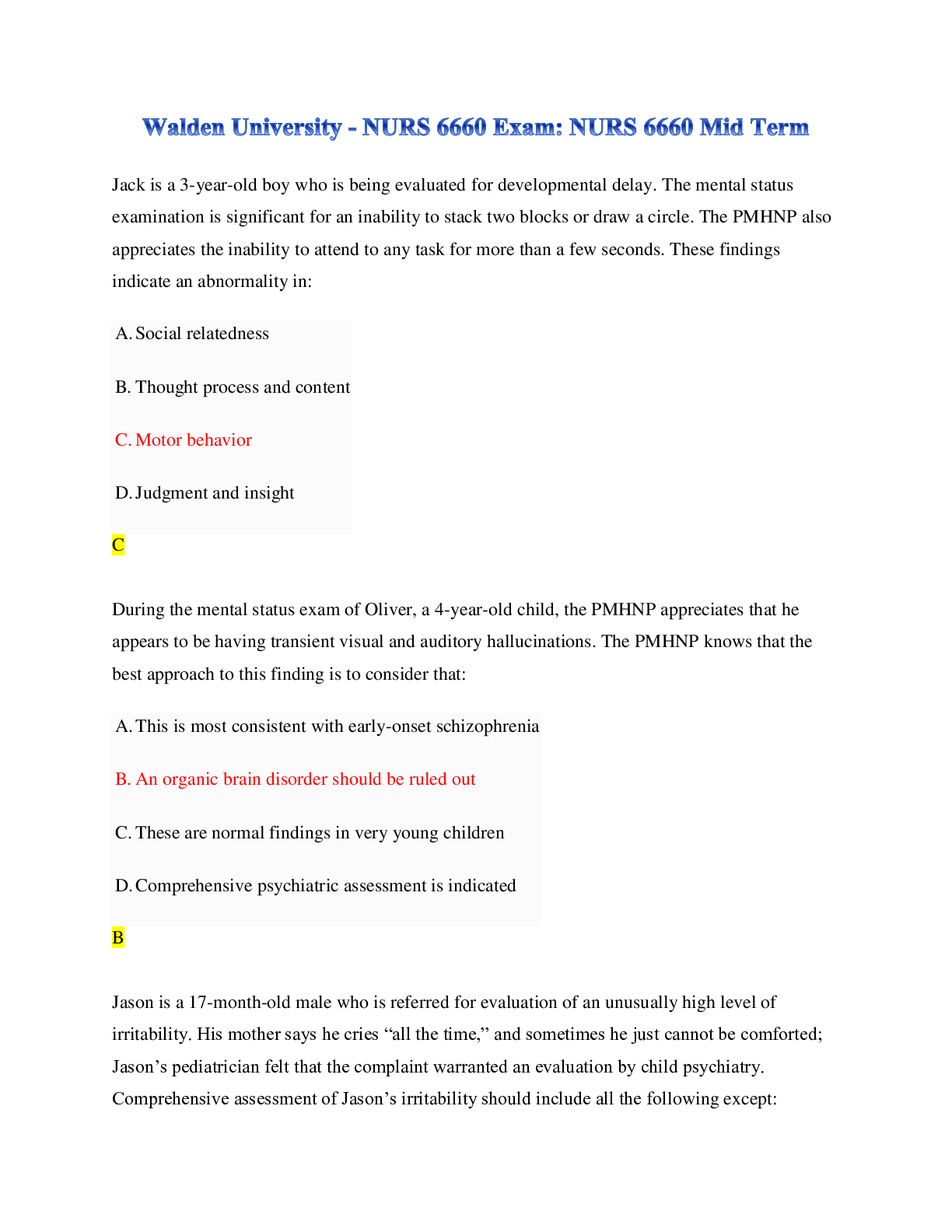
Document information
Connected school, study & course
About the document
Uploaded On
Jun 01, 2020
Number of pages
36
Written in
Additional information
This document has been written for:
Uploaded
Jun 01, 2020
Downloads
7
Views
345


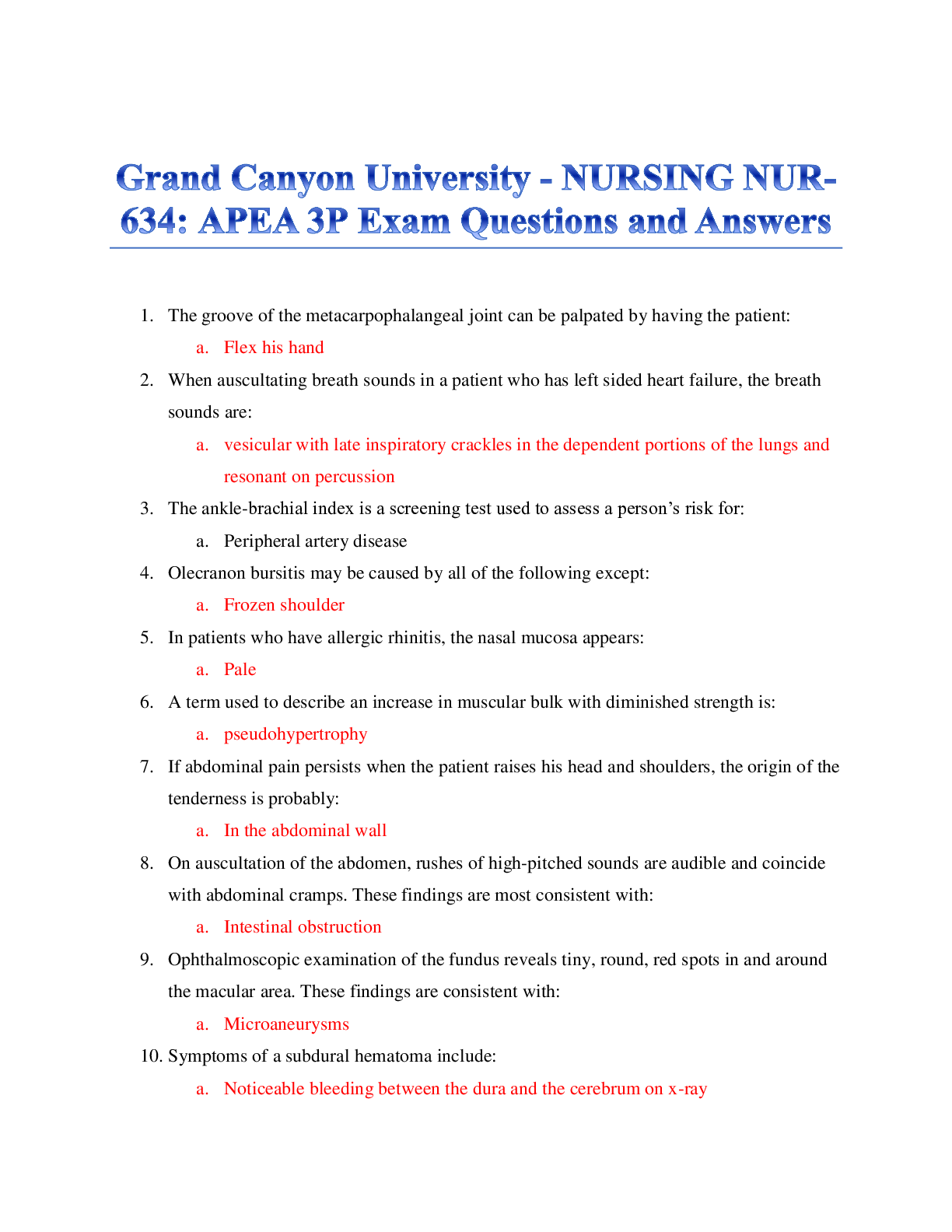
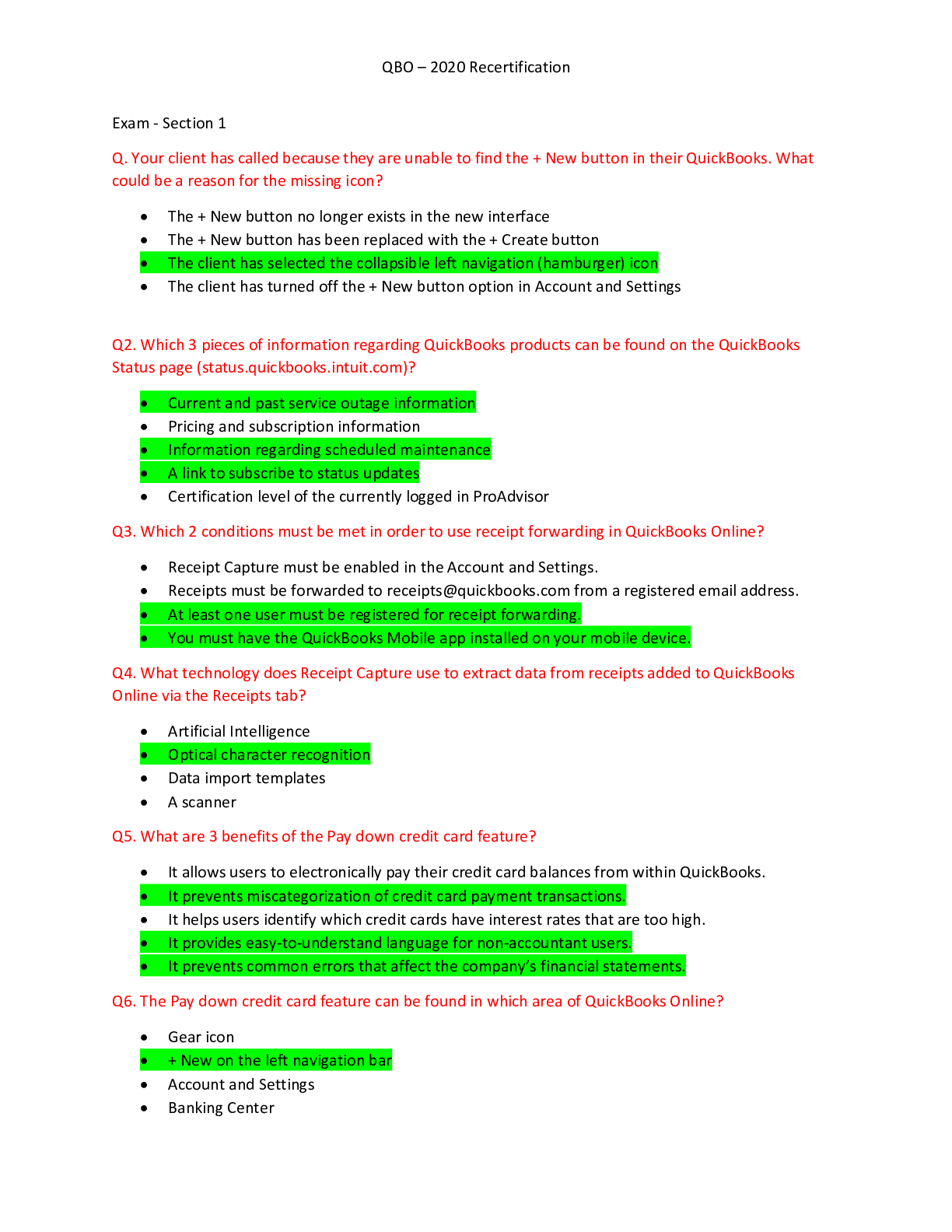
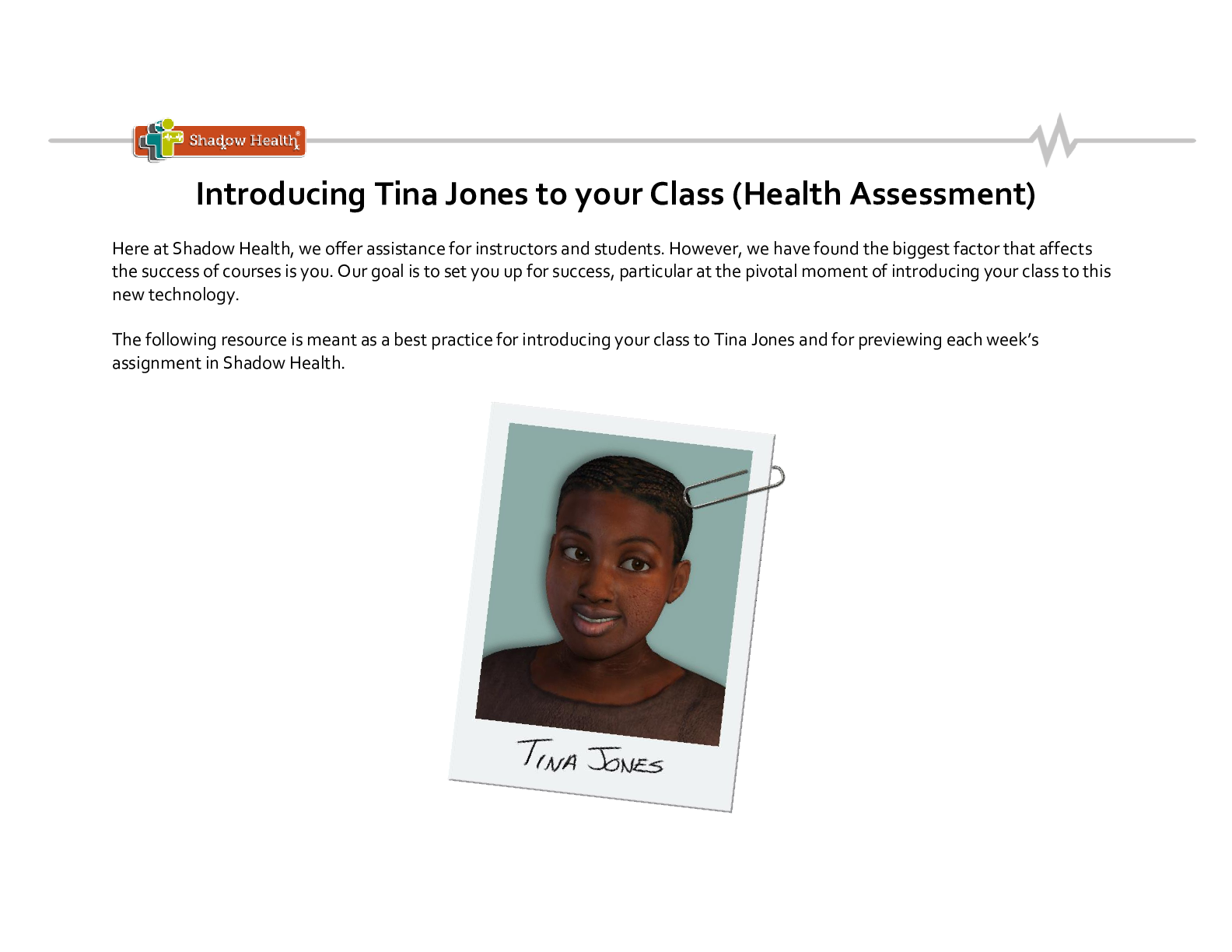

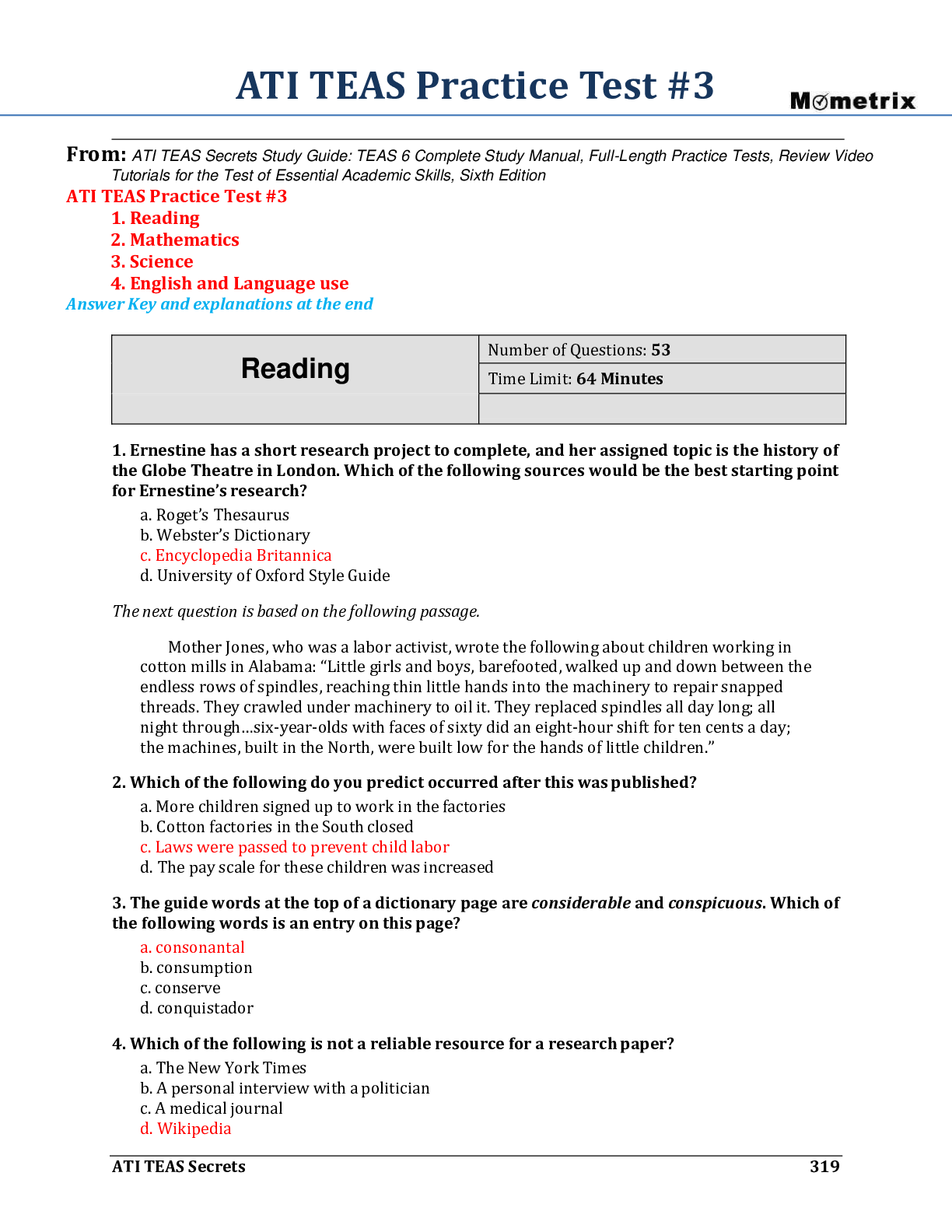
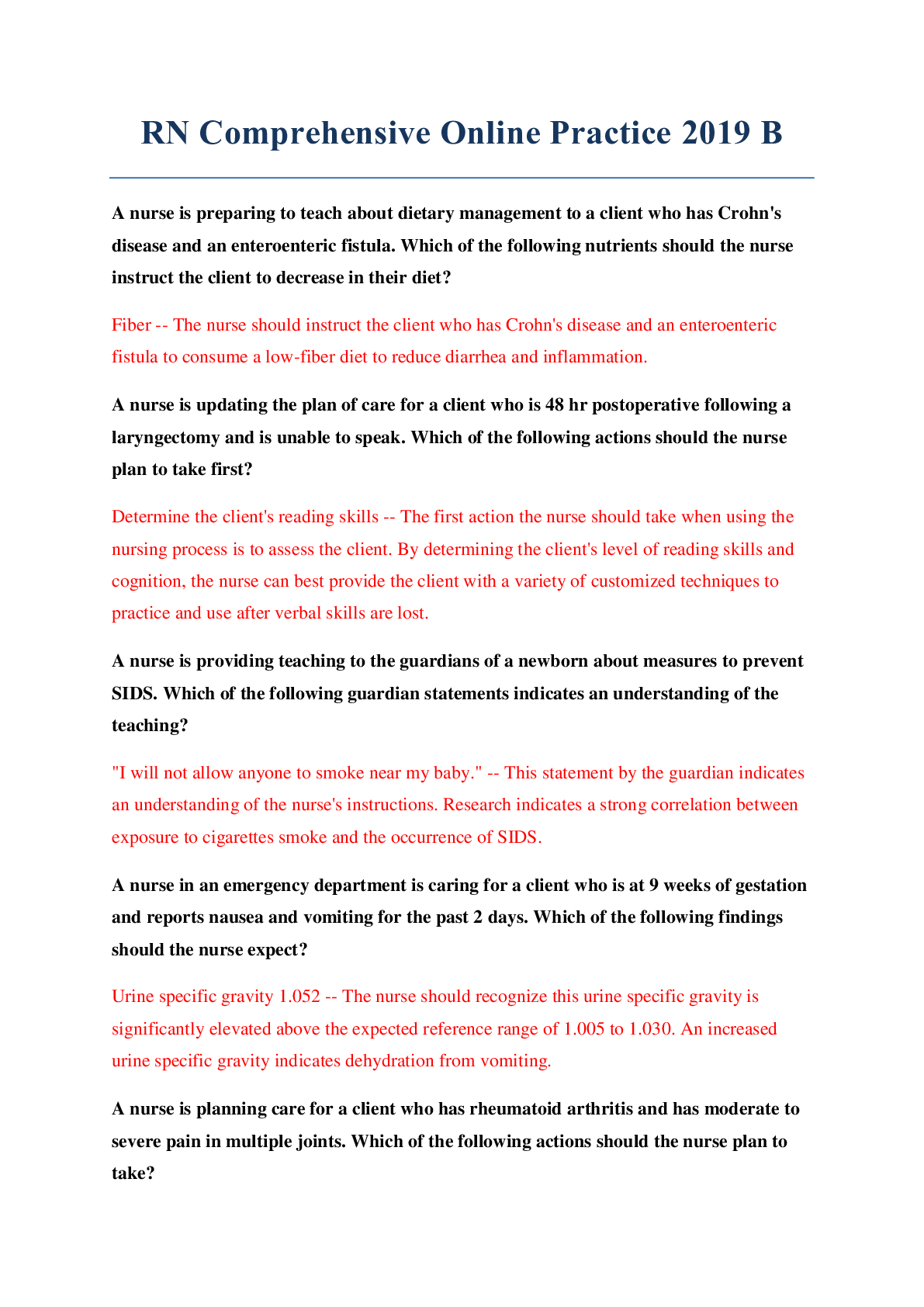

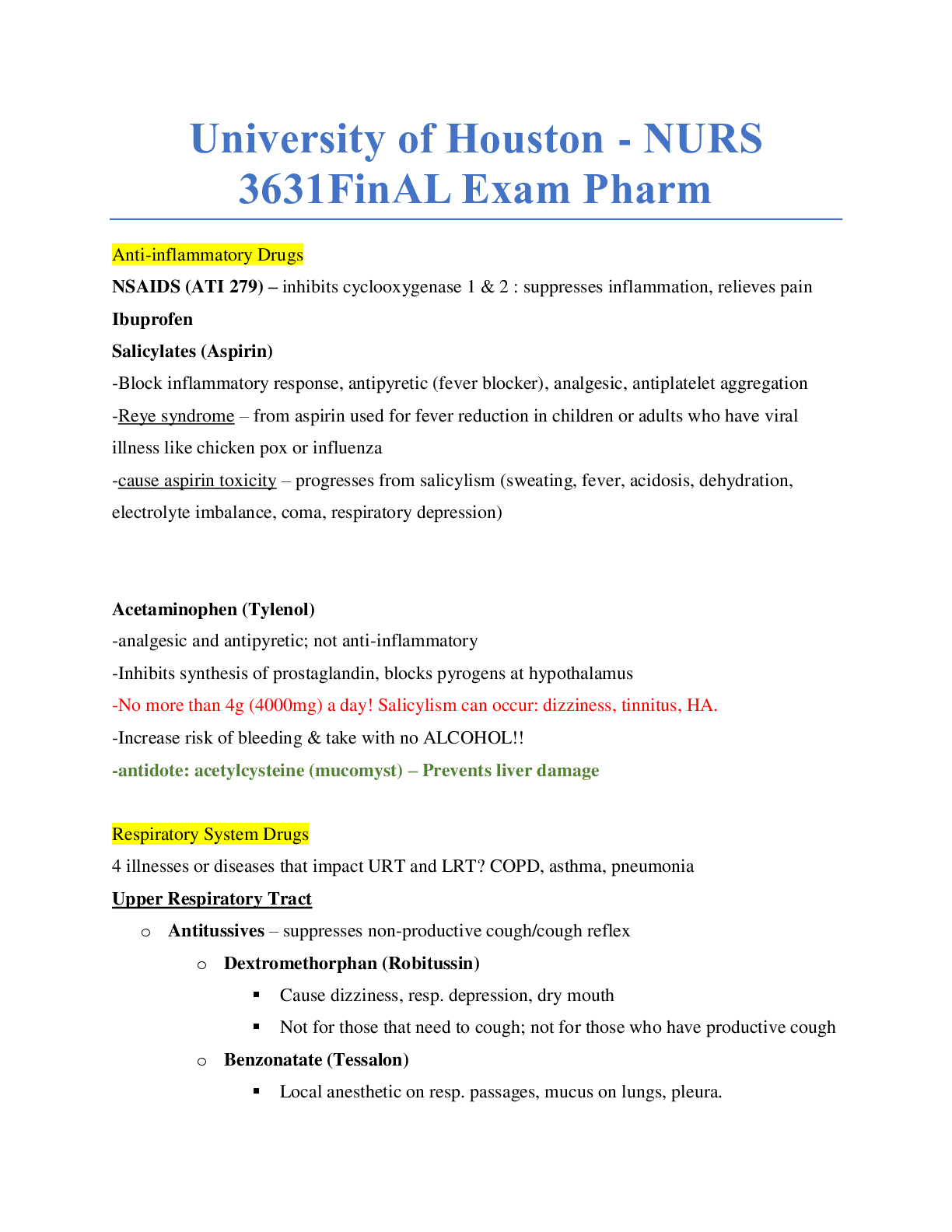
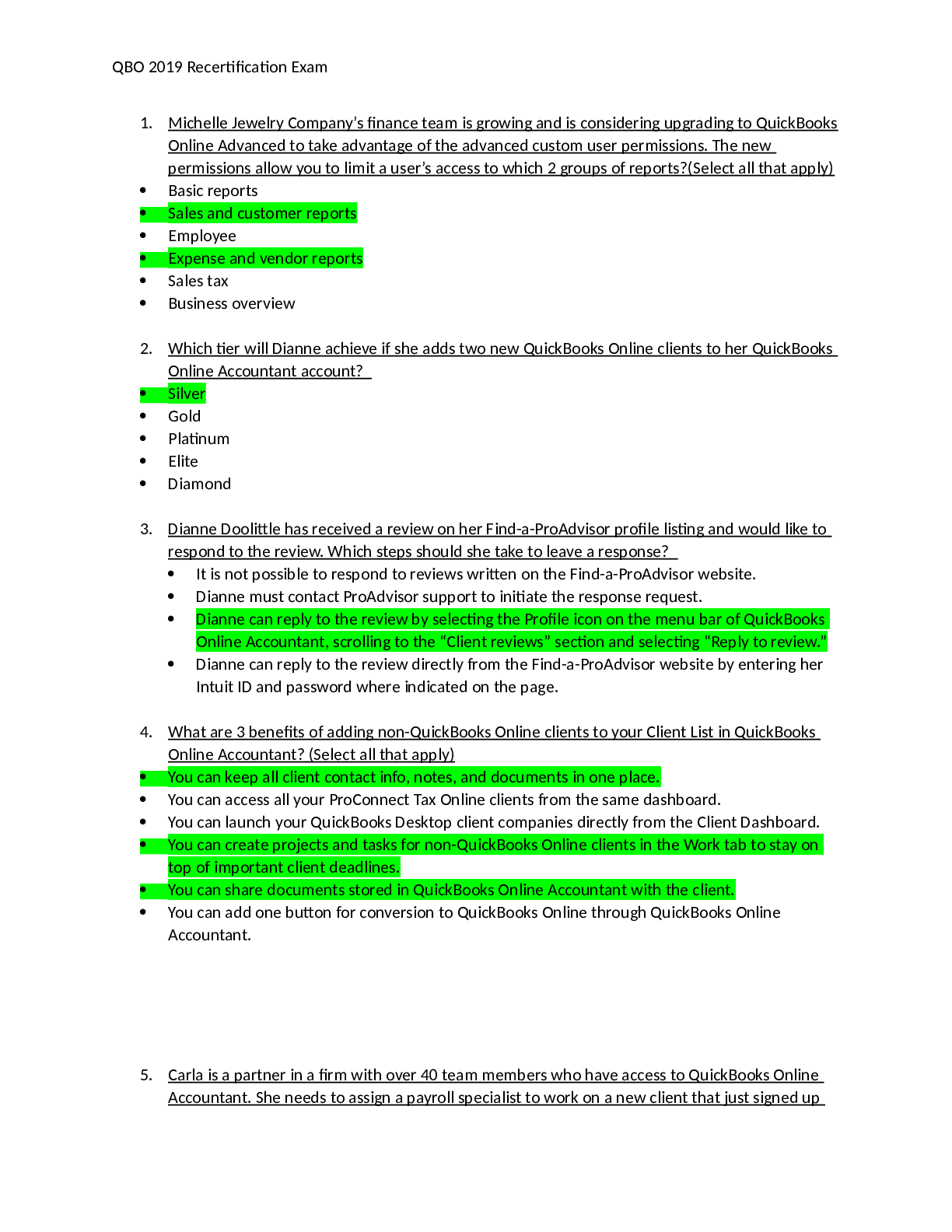
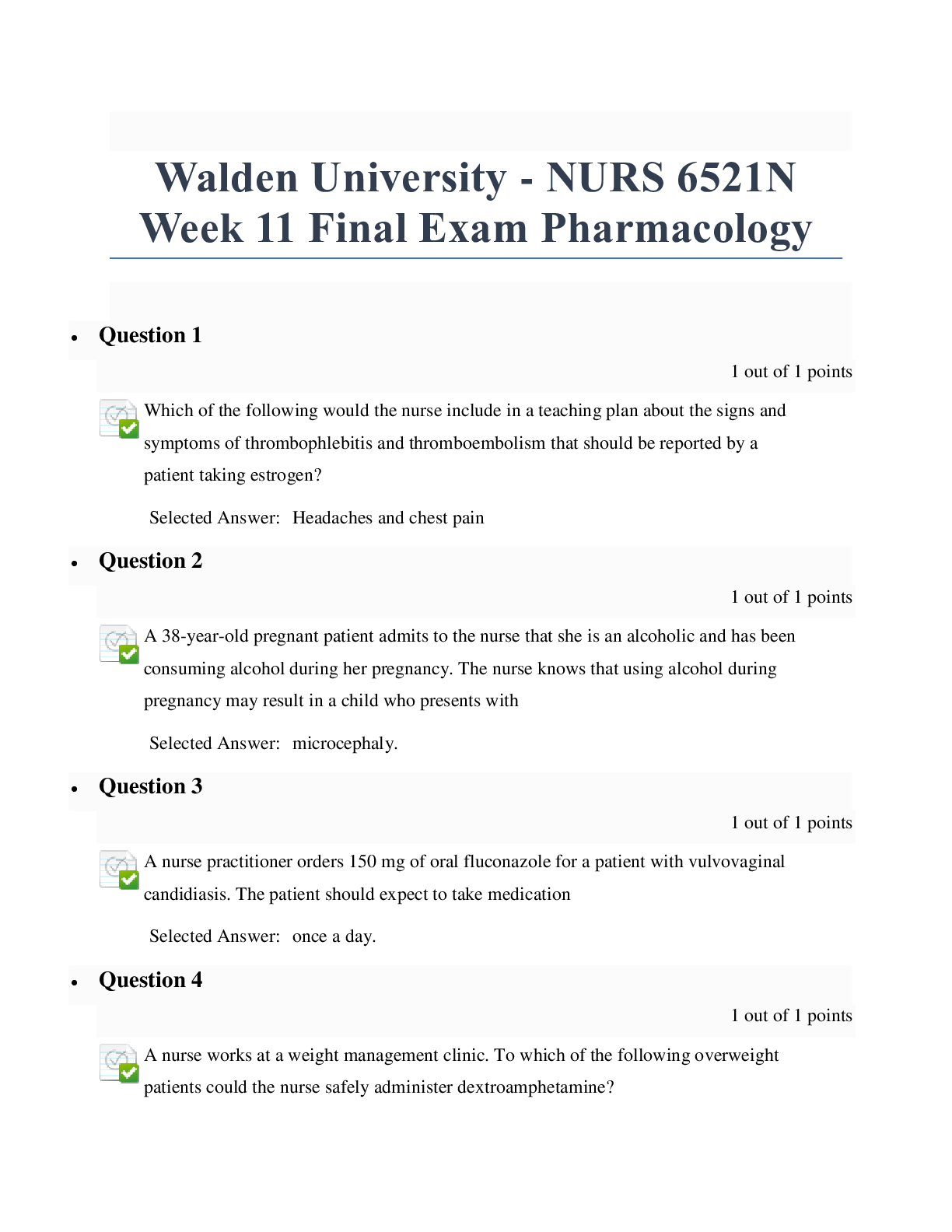
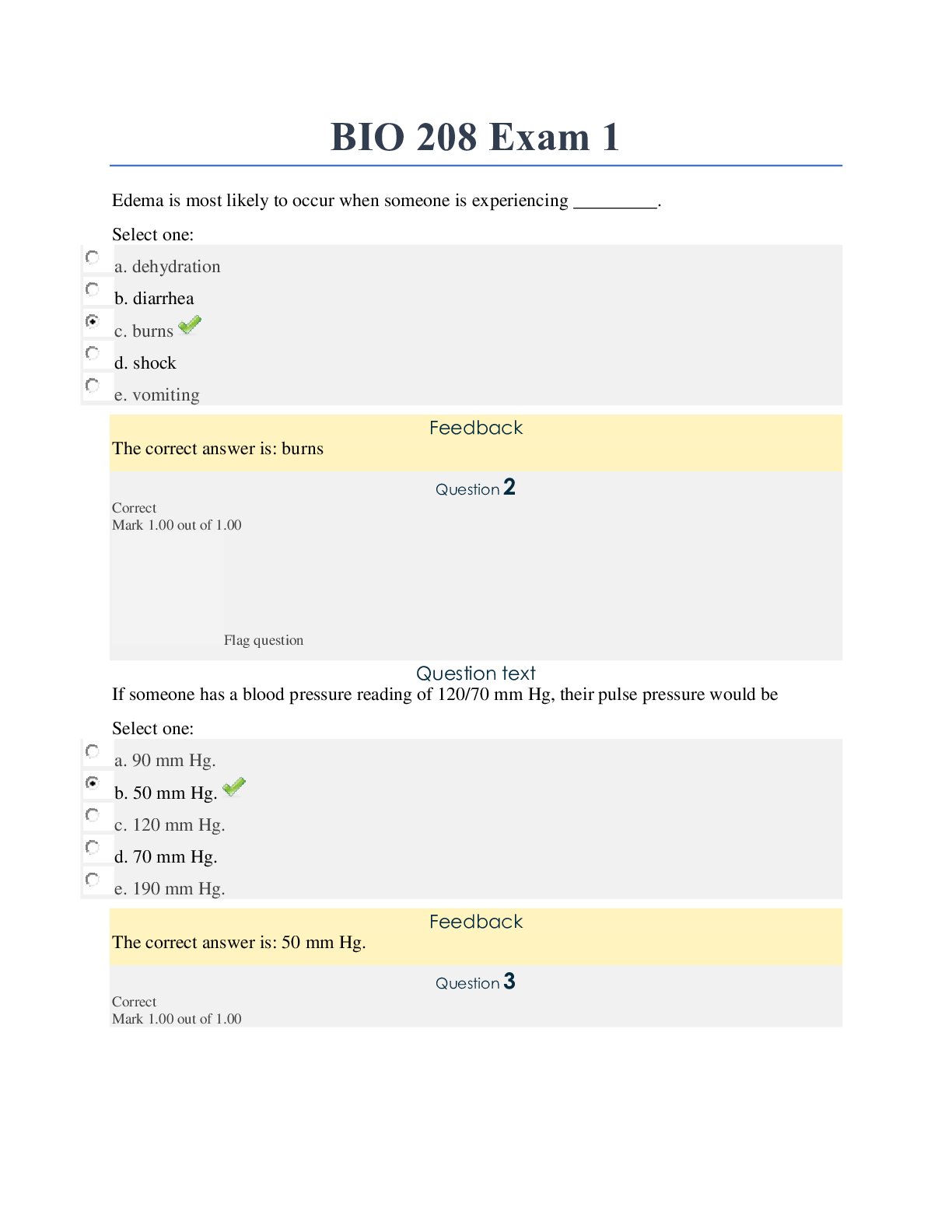
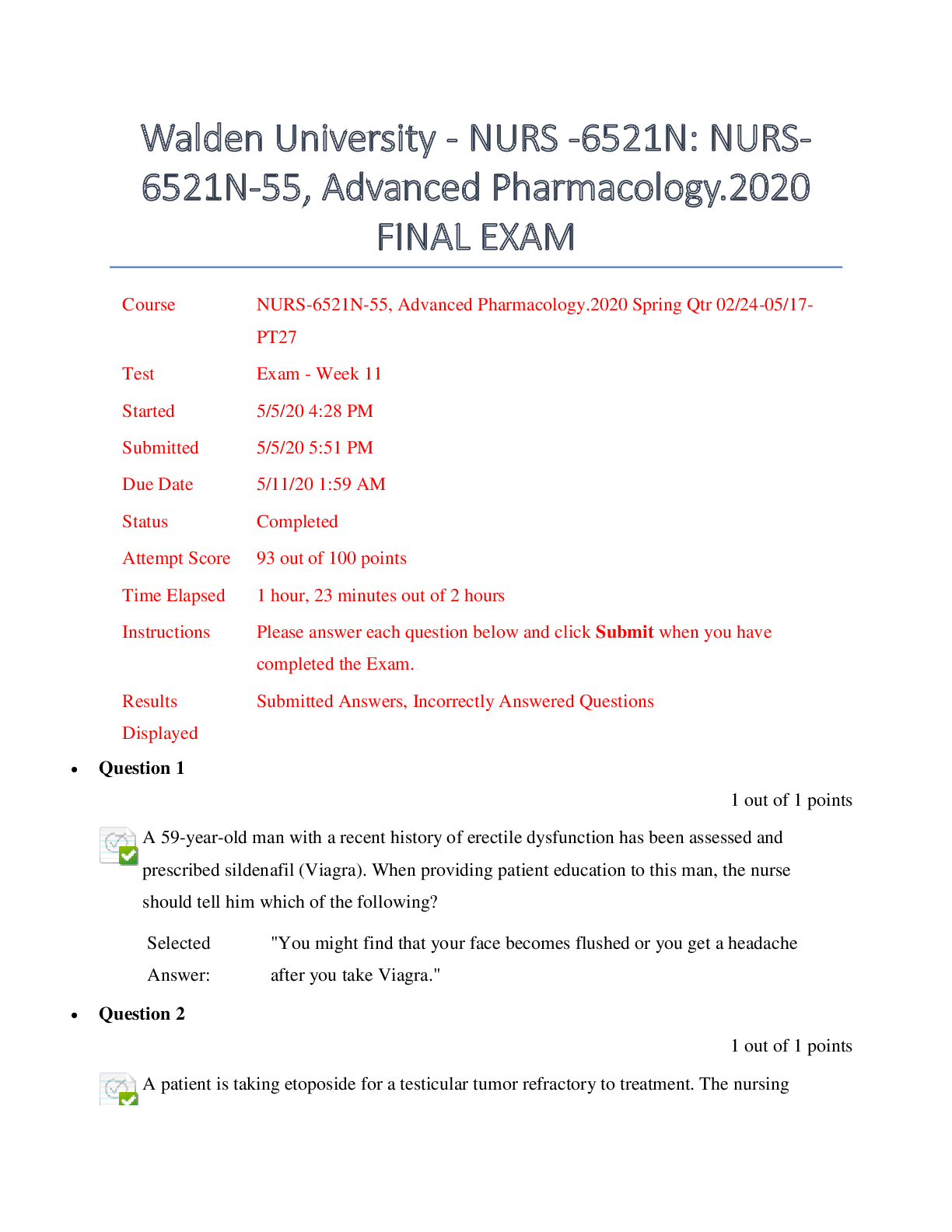
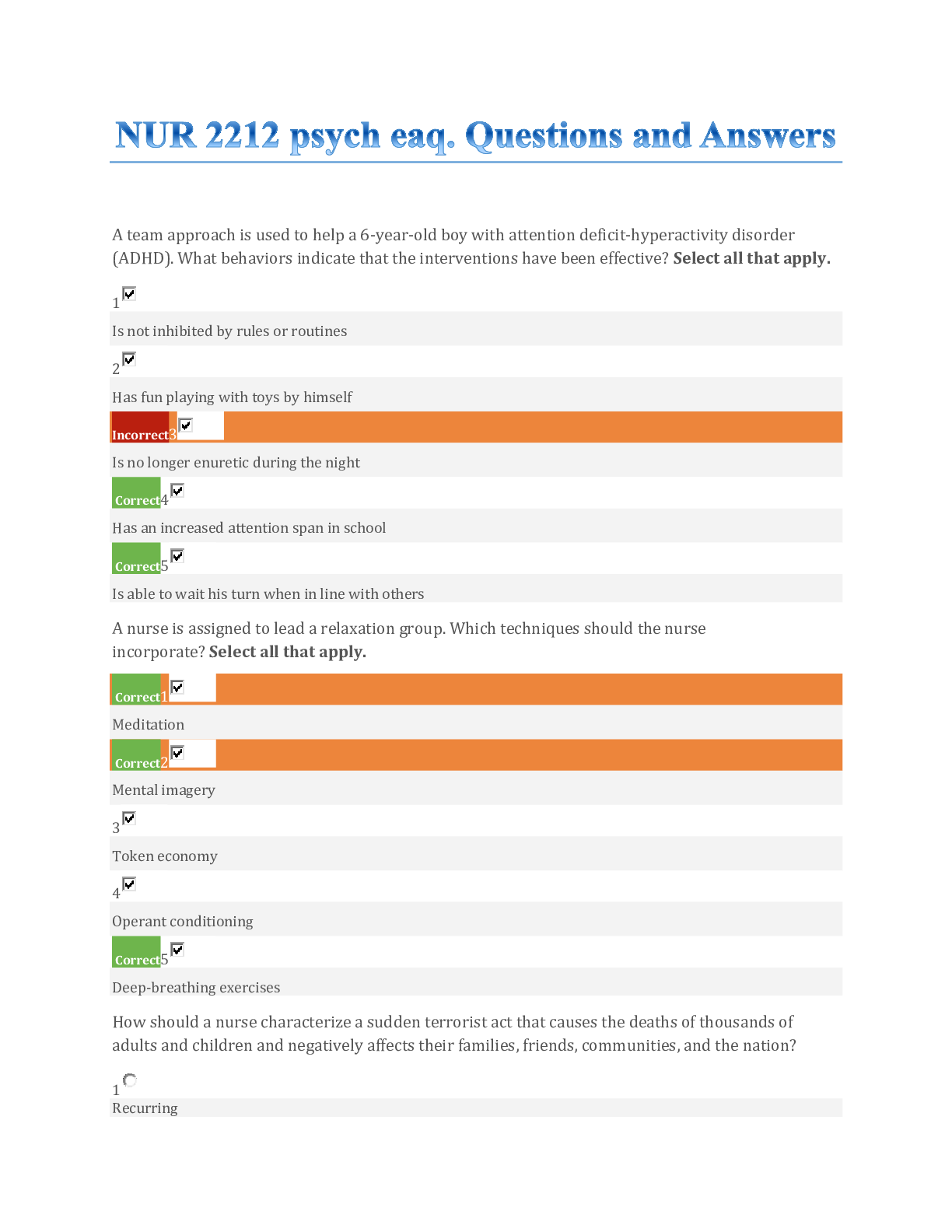
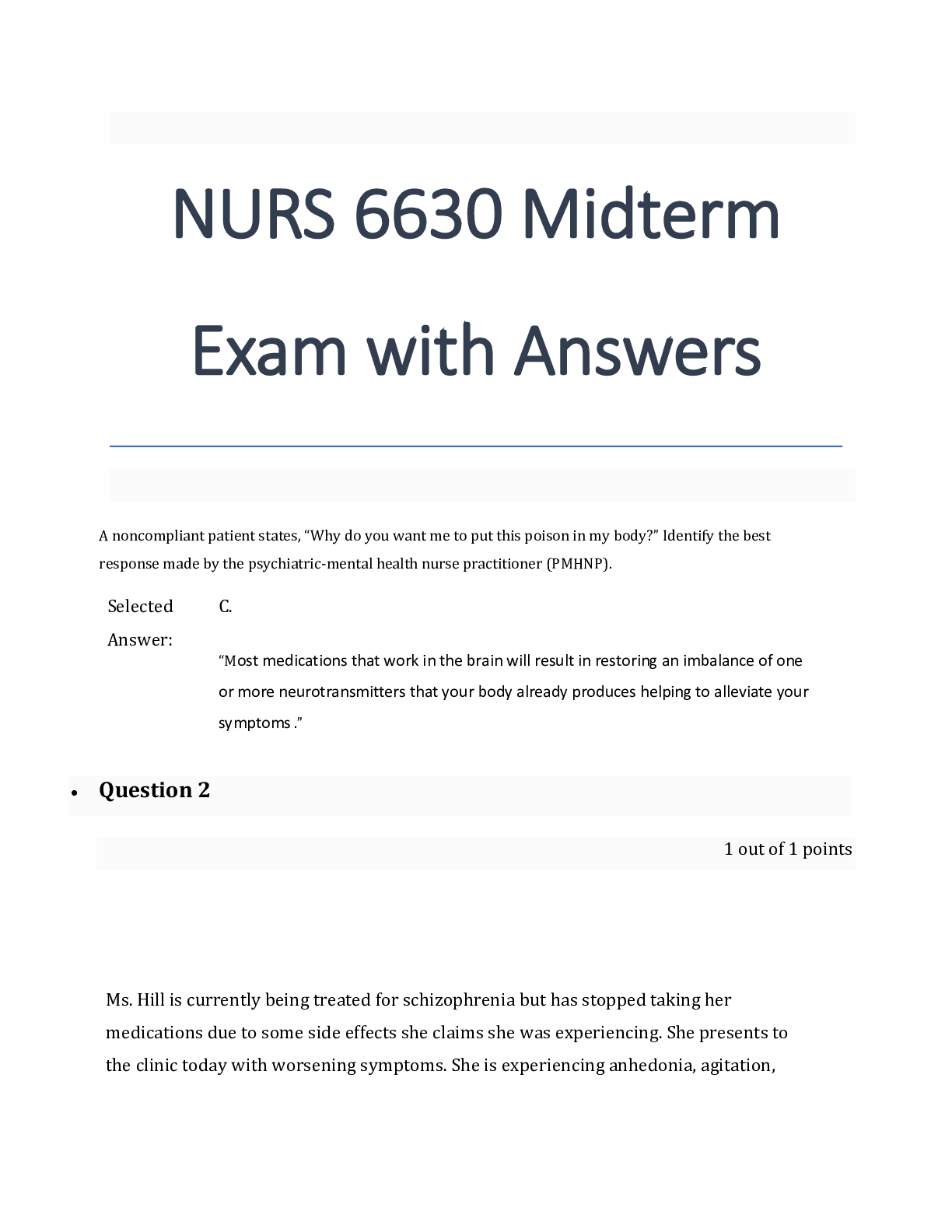

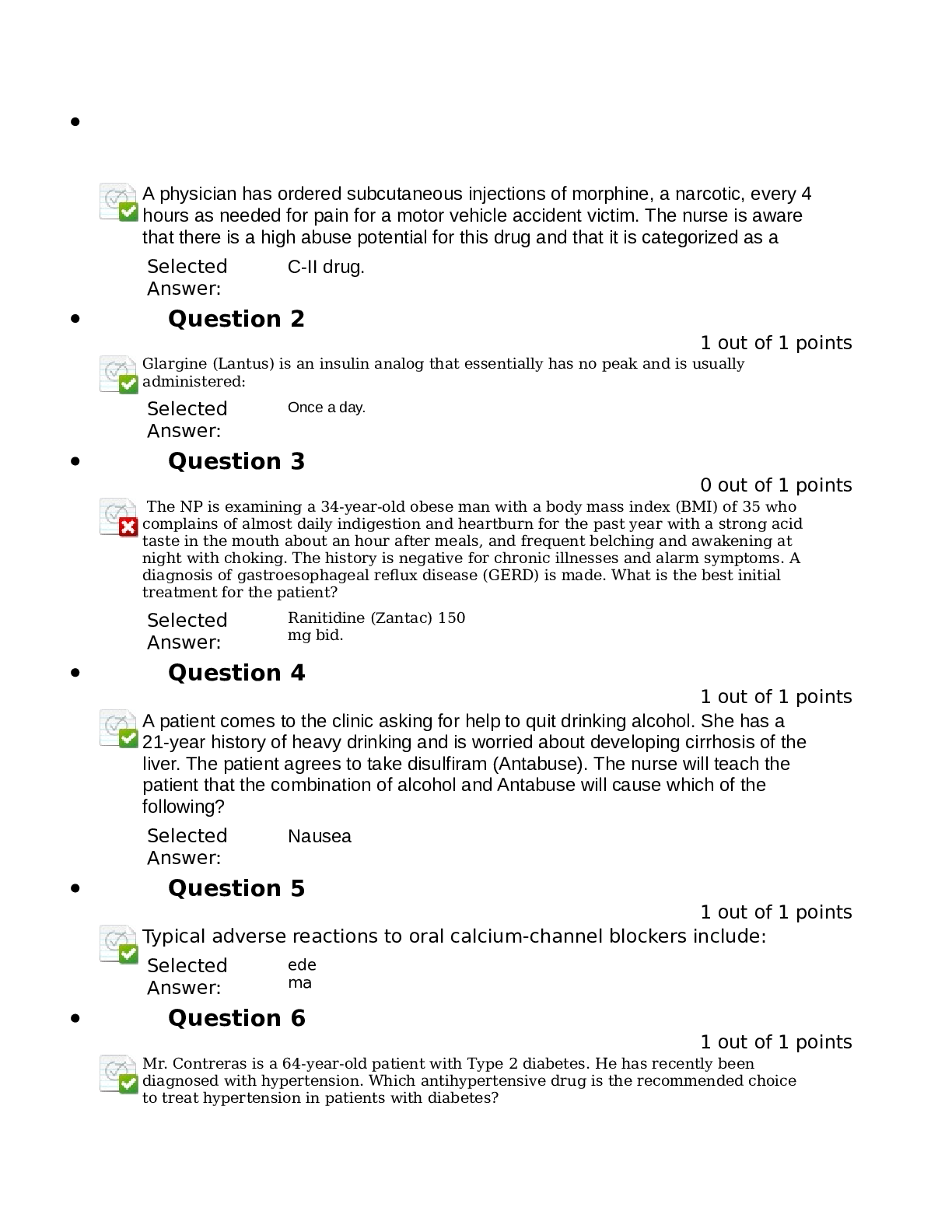
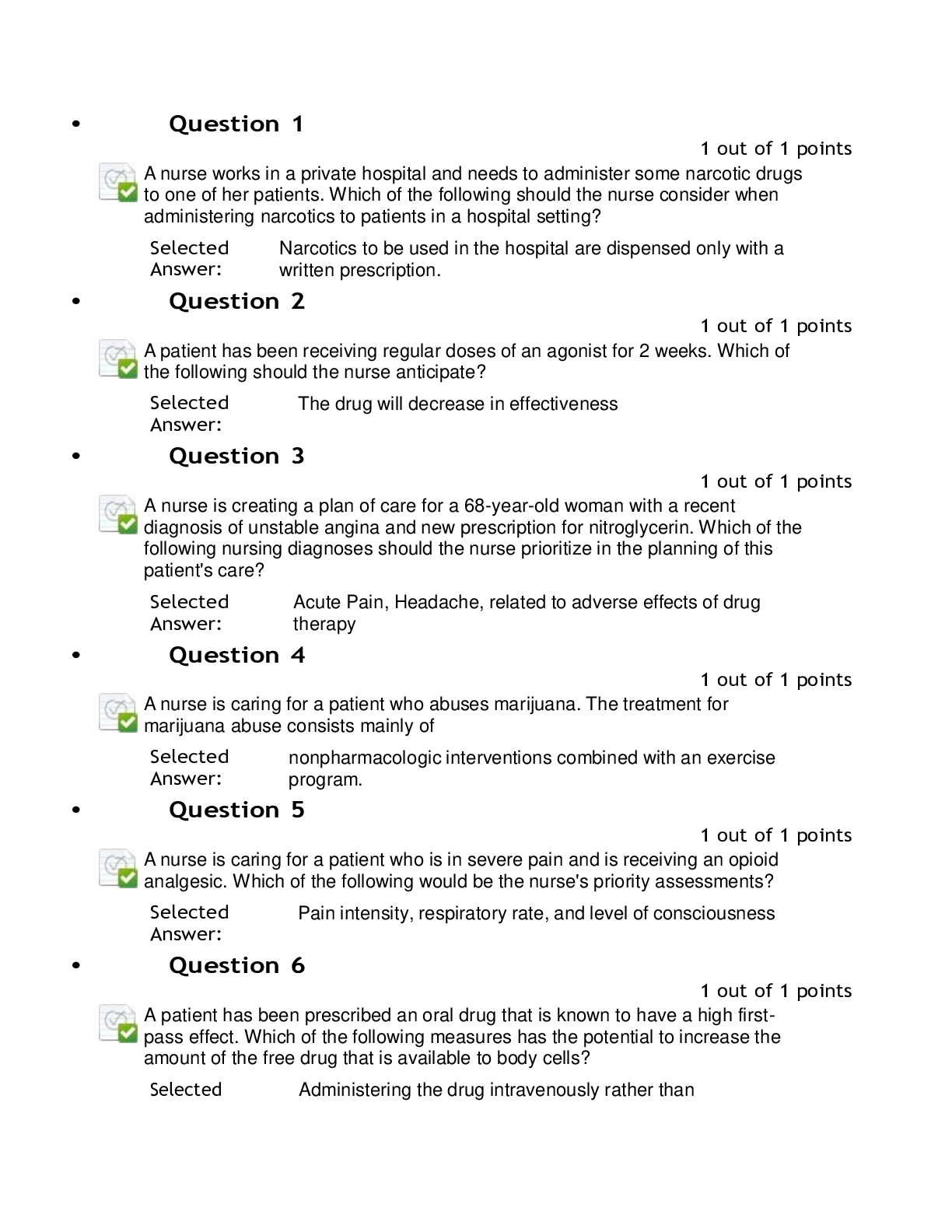
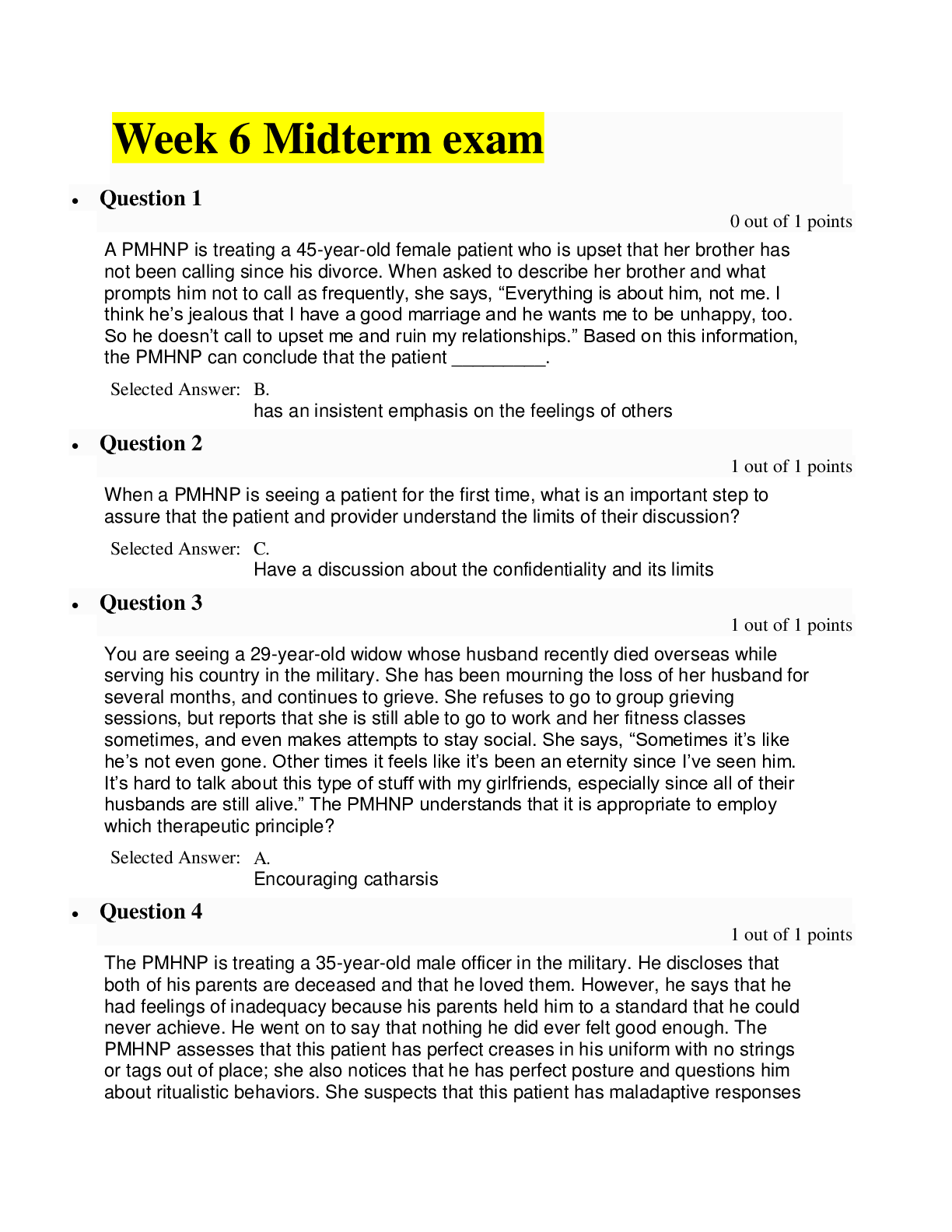
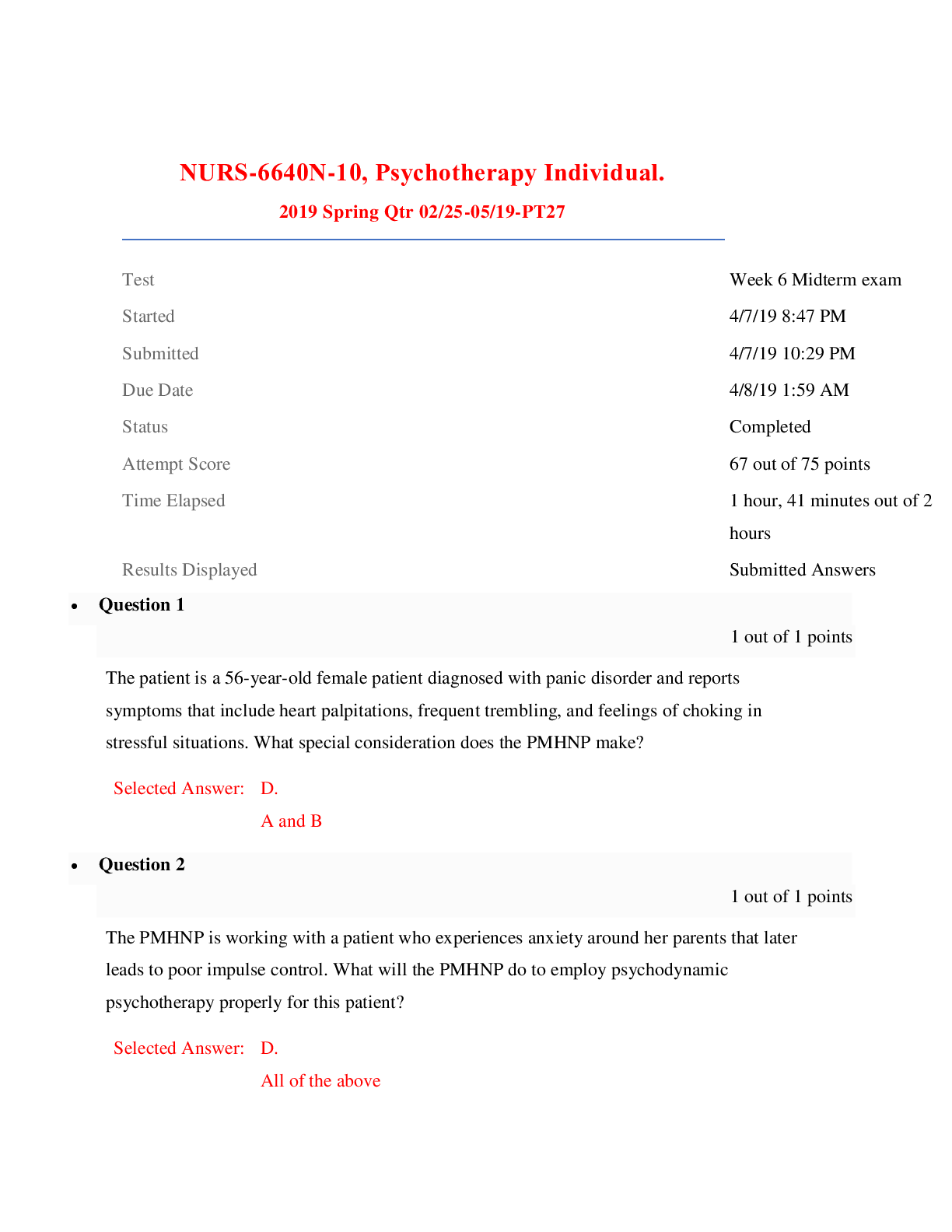
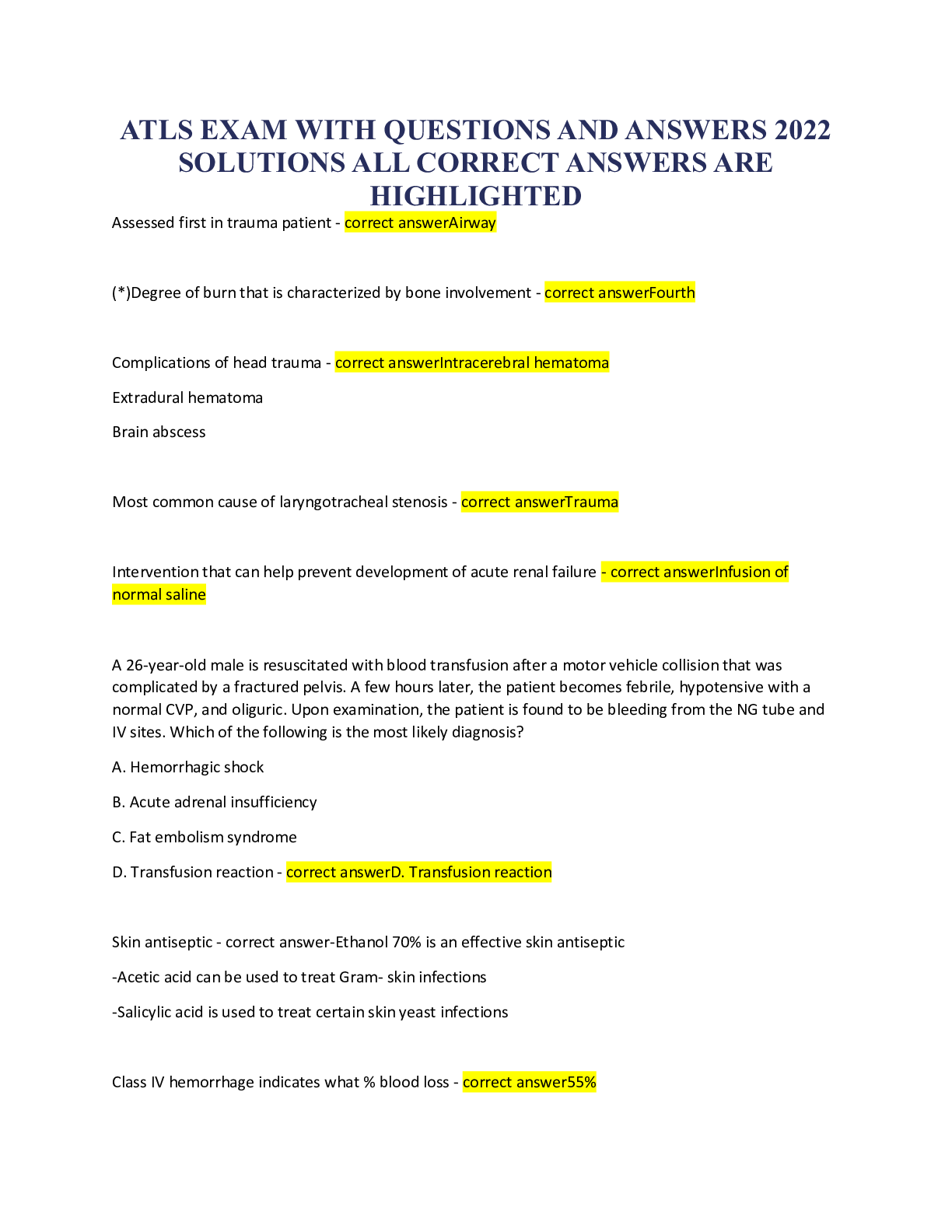

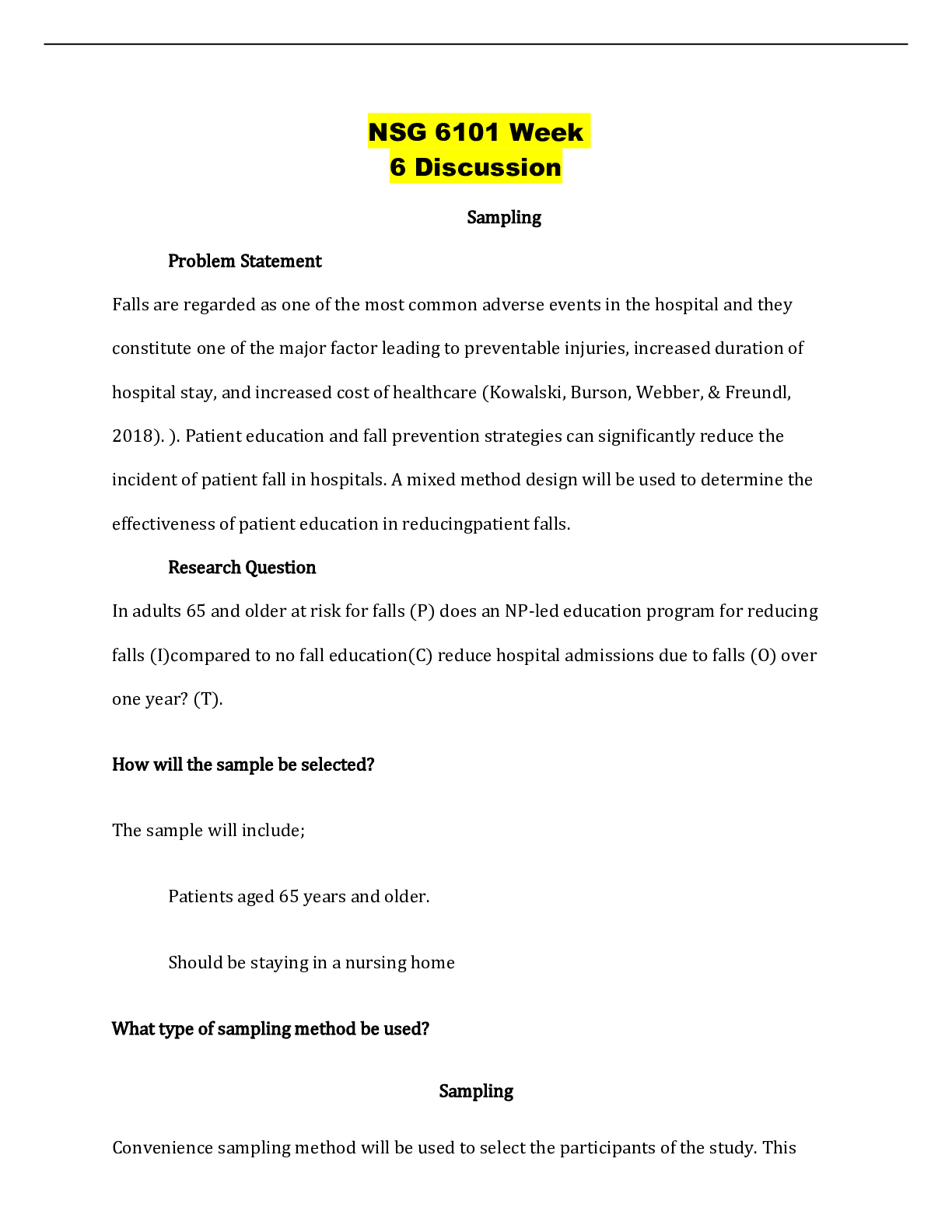
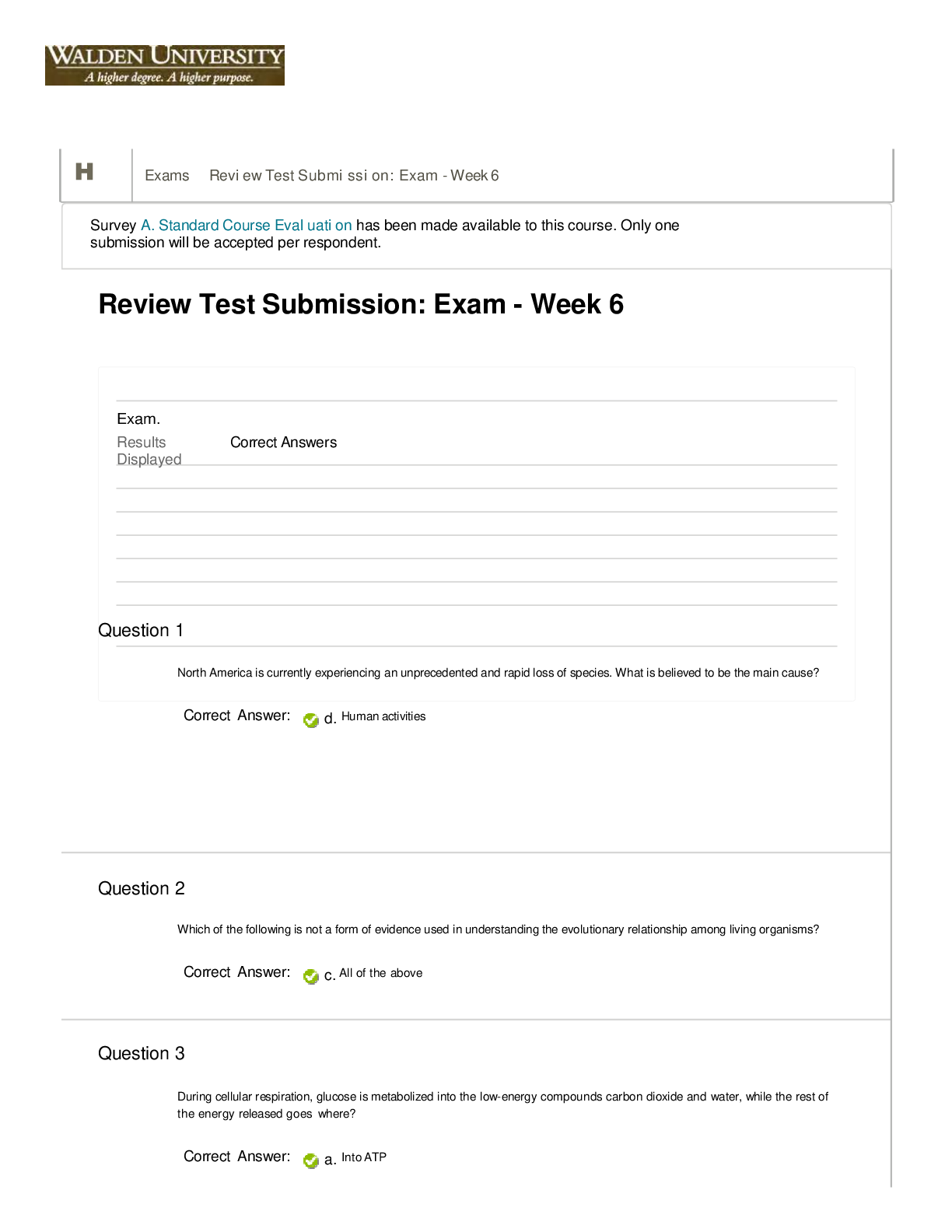
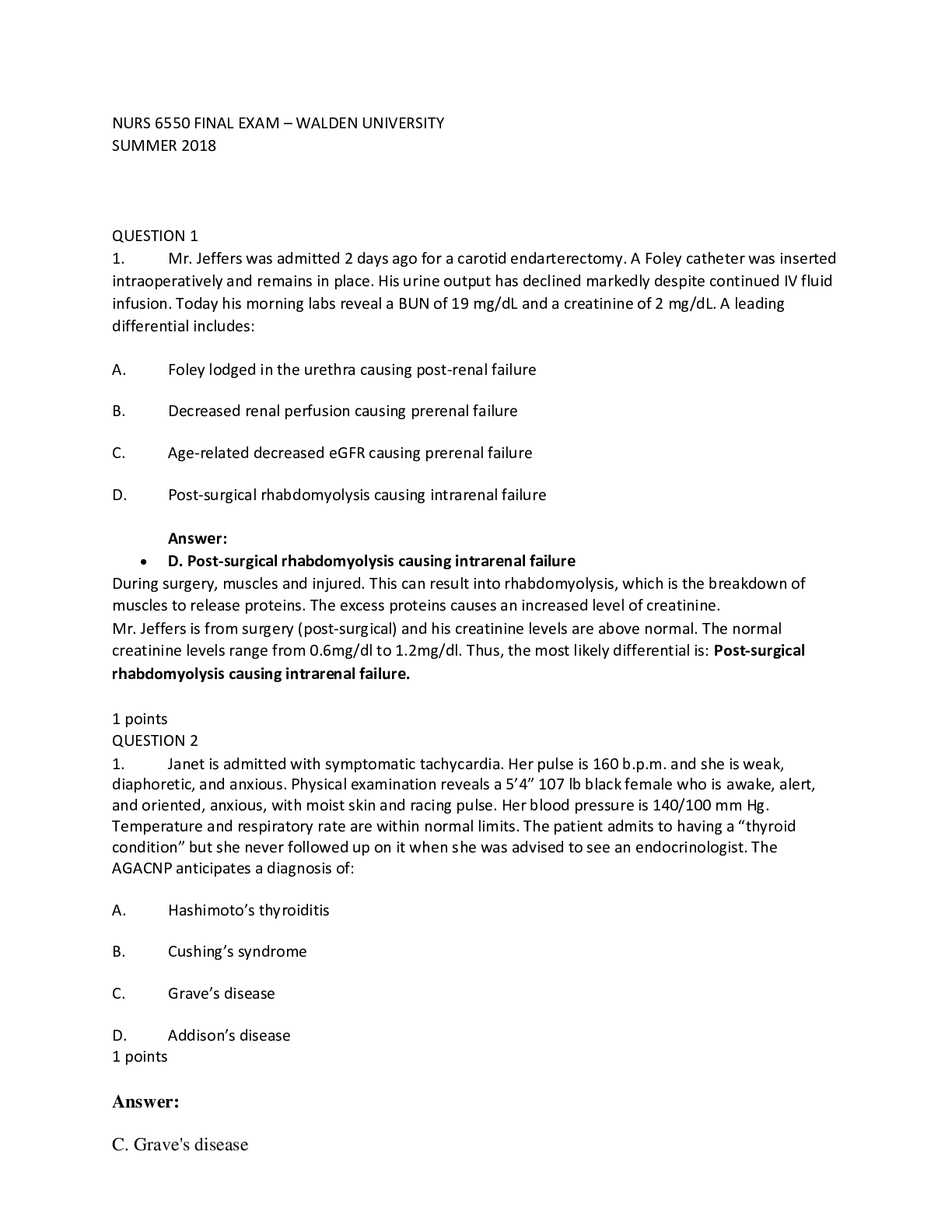
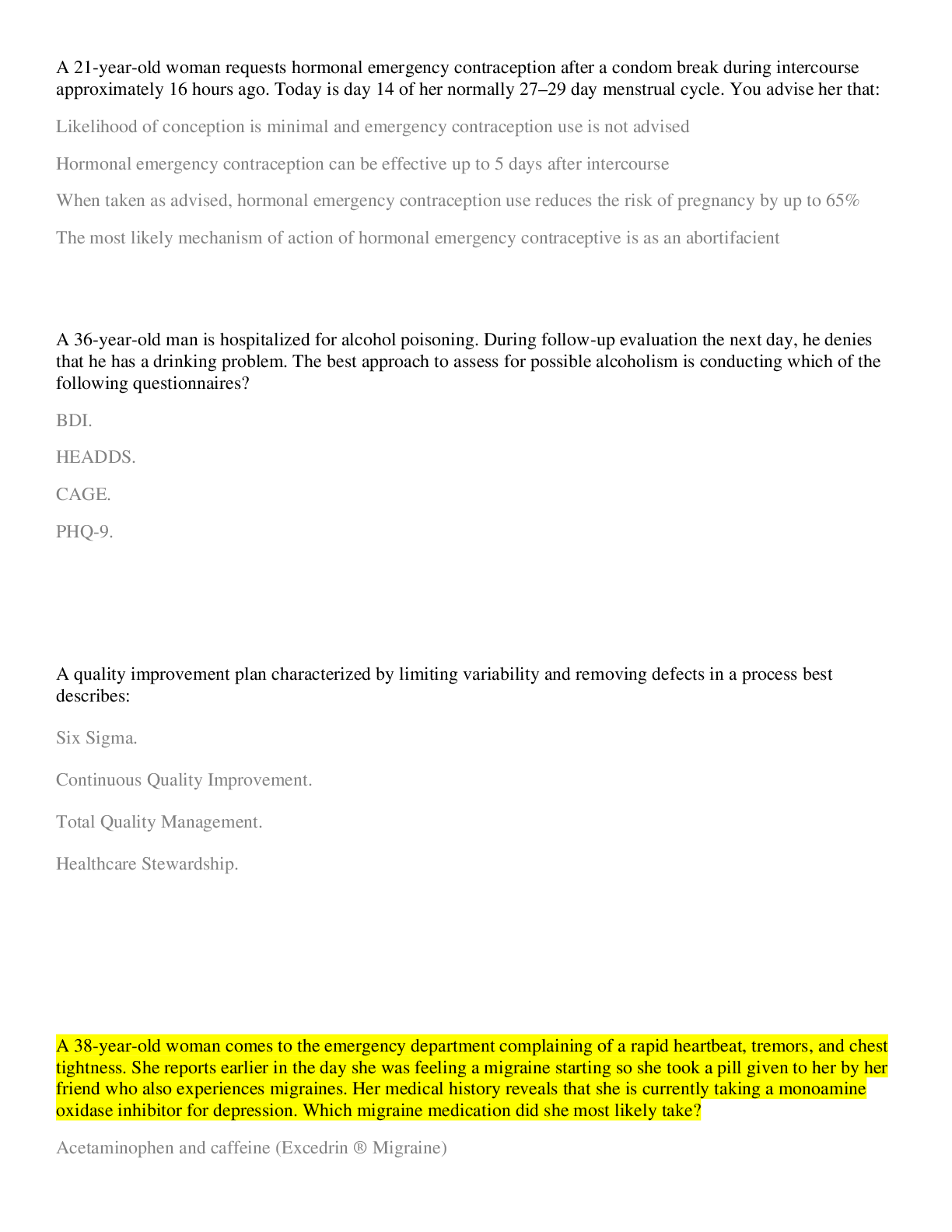
.png)
